Effective Business Communications - Assignment
VerifiedAdded on 2021/05/31
|17
|4905
|17
AI Summary
Contribute Materials
Your contribution can guide someone’s learning journey. Share your
documents today.
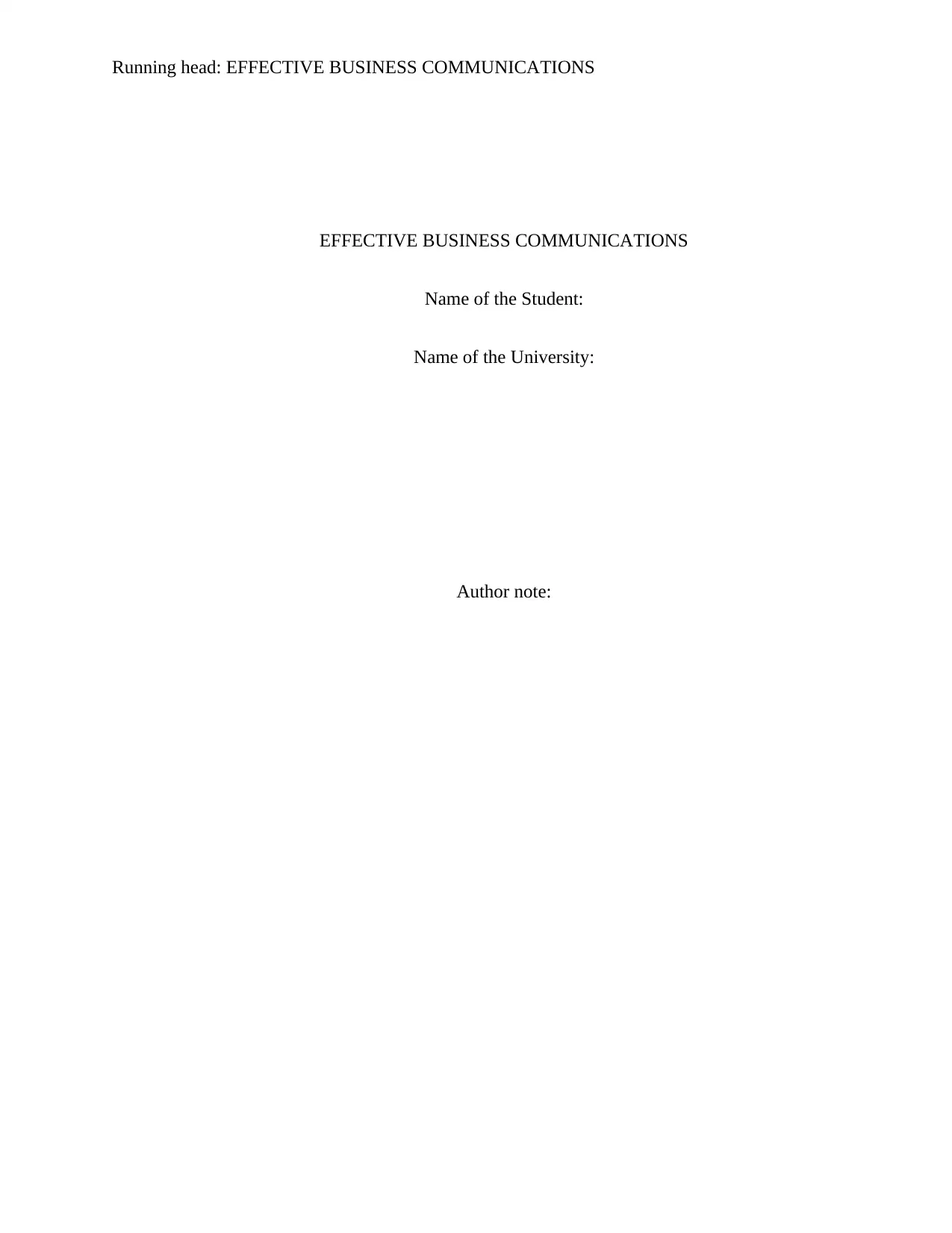
Running head: EFFECTIVE BUSINESS COMMUNICATIONS
EFFECTIVE BUSINESS COMMUNICATIONS
Name of the Student:
Name of the University:
Author note:
EFFECTIVE BUSINESS COMMUNICATIONS
Name of the Student:
Name of the University:
Author note:
Secure Best Marks with AI Grader
Need help grading? Try our AI Grader for instant feedback on your assignments.
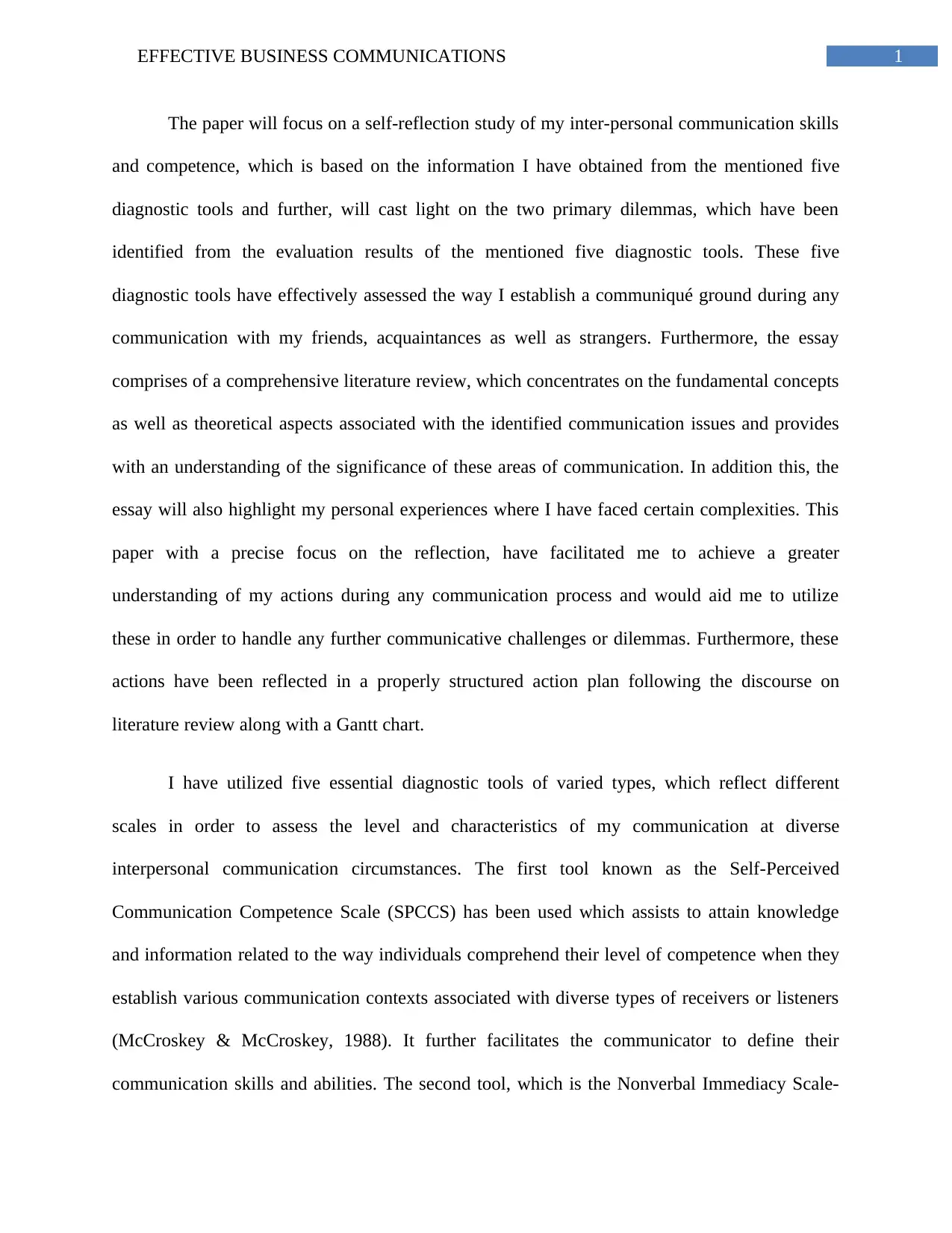
1EFFECTIVE BUSINESS COMMUNICATIONS
The paper will focus on a self-reflection study of my inter-personal communication skills
and competence, which is based on the information I have obtained from the mentioned five
diagnostic tools and further, will cast light on the two primary dilemmas, which have been
identified from the evaluation results of the mentioned five diagnostic tools. These five
diagnostic tools have effectively assessed the way I establish a communiqué ground during any
communication with my friends, acquaintances as well as strangers. Furthermore, the essay
comprises of a comprehensive literature review, which concentrates on the fundamental concepts
as well as theoretical aspects associated with the identified communication issues and provides
with an understanding of the significance of these areas of communication. In addition this, the
essay will also highlight my personal experiences where I have faced certain complexities. This
paper with a precise focus on the reflection, have facilitated me to achieve a greater
understanding of my actions during any communication process and would aid me to utilize
these in order to handle any further communicative challenges or dilemmas. Furthermore, these
actions have been reflected in a properly structured action plan following the discourse on
literature review along with a Gantt chart.
I have utilized five essential diagnostic tools of varied types, which reflect different
scales in order to assess the level and characteristics of my communication at diverse
interpersonal communication circumstances. The first tool known as the Self-Perceived
Communication Competence Scale (SPCCS) has been used which assists to attain knowledge
and information related to the way individuals comprehend their level of competence when they
establish various communication contexts associated with diverse types of receivers or listeners
(McCroskey & McCroskey, 1988). It further facilitates the communicator to define their
communication skills and abilities. The second tool, which is the Nonverbal Immediacy Scale-
The paper will focus on a self-reflection study of my inter-personal communication skills
and competence, which is based on the information I have obtained from the mentioned five
diagnostic tools and further, will cast light on the two primary dilemmas, which have been
identified from the evaluation results of the mentioned five diagnostic tools. These five
diagnostic tools have effectively assessed the way I establish a communiqué ground during any
communication with my friends, acquaintances as well as strangers. Furthermore, the essay
comprises of a comprehensive literature review, which concentrates on the fundamental concepts
as well as theoretical aspects associated with the identified communication issues and provides
with an understanding of the significance of these areas of communication. In addition this, the
essay will also highlight my personal experiences where I have faced certain complexities. This
paper with a precise focus on the reflection, have facilitated me to achieve a greater
understanding of my actions during any communication process and would aid me to utilize
these in order to handle any further communicative challenges or dilemmas. Furthermore, these
actions have been reflected in a properly structured action plan following the discourse on
literature review along with a Gantt chart.
I have utilized five essential diagnostic tools of varied types, which reflect different
scales in order to assess the level and characteristics of my communication at diverse
interpersonal communication circumstances. The first tool known as the Self-Perceived
Communication Competence Scale (SPCCS) has been used which assists to attain knowledge
and information related to the way individuals comprehend their level of competence when they
establish various communication contexts associated with diverse types of receivers or listeners
(McCroskey & McCroskey, 1988). It further facilitates the communicator to define their
communication skills and abilities. The second tool, which is the Nonverbal Immediacy Scale-
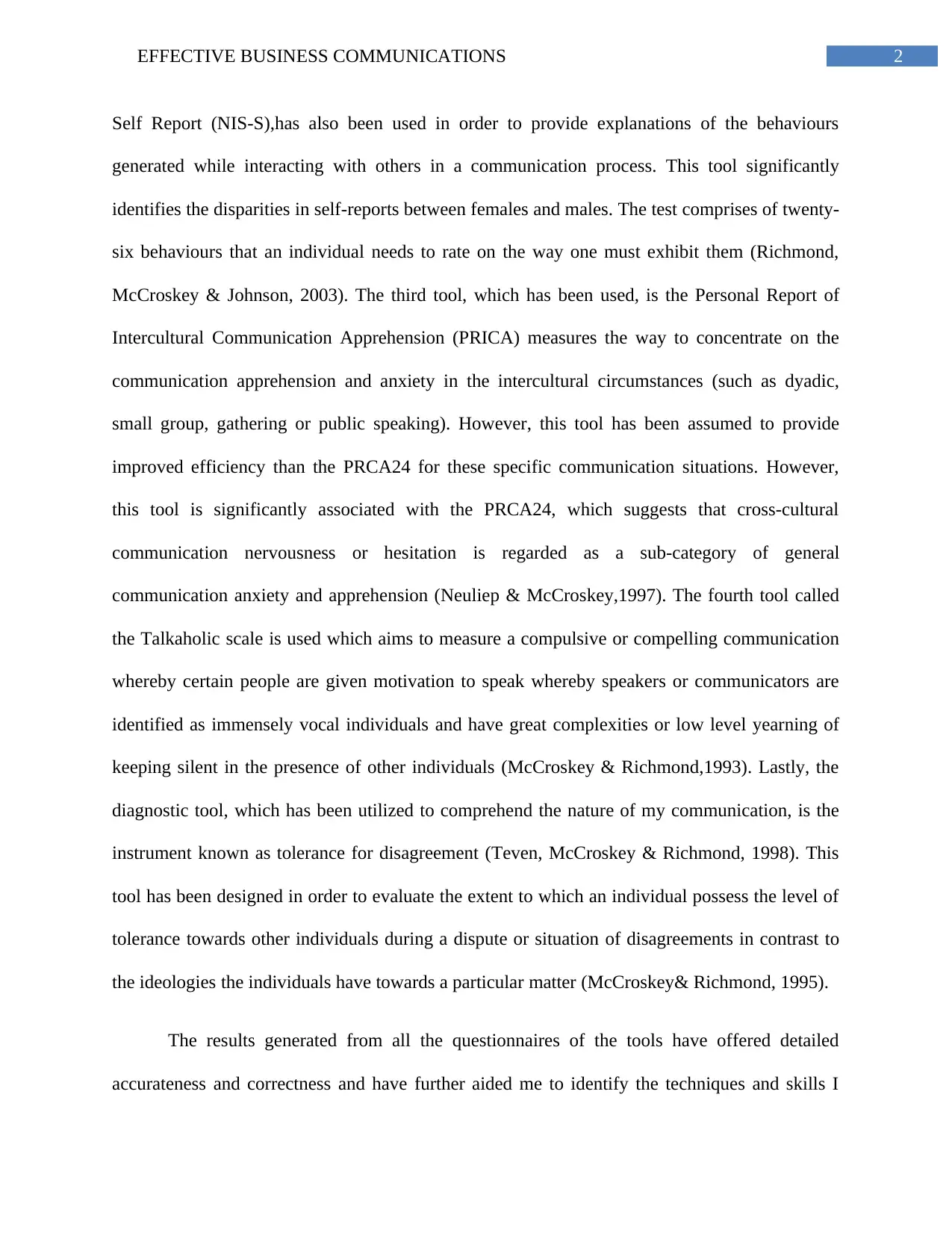
2EFFECTIVE BUSINESS COMMUNICATIONS
Self Report (NIS-S),has also been used in order to provide explanations of the behaviours
generated while interacting with others in a communication process. This tool significantly
identifies the disparities in self-reports between females and males. The test comprises of twenty-
six behaviours that an individual needs to rate on the way one must exhibit them (Richmond,
McCroskey & Johnson, 2003). The third tool, which has been used, is the Personal Report of
Intercultural Communication Apprehension (PRICA) measures the way to concentrate on the
communication apprehension and anxiety in the intercultural circumstances (such as dyadic,
small group, gathering or public speaking). However, this tool has been assumed to provide
improved efficiency than the PRCA24 for these specific communication situations. However,
this tool is significantly associated with the PRCA24, which suggests that cross-cultural
communication nervousness or hesitation is regarded as a sub-category of general
communication anxiety and apprehension (Neuliep & McCroskey,1997). The fourth tool called
the Talkaholic scale is used which aims to measure a compulsive or compelling communication
whereby certain people are given motivation to speak whereby speakers or communicators are
identified as immensely vocal individuals and have great complexities or low level yearning of
keeping silent in the presence of other individuals (McCroskey & Richmond,1993). Lastly, the
diagnostic tool, which has been utilized to comprehend the nature of my communication, is the
instrument known as tolerance for disagreement (Teven, McCroskey & Richmond, 1998). This
tool has been designed in order to evaluate the extent to which an individual possess the level of
tolerance towards other individuals during a dispute or situation of disagreements in contrast to
the ideologies the individuals have towards a particular matter (McCroskey& Richmond, 1995).
The results generated from all the questionnaires of the tools have offered detailed
accurateness and correctness and have further aided me to identify the techniques and skills I
Self Report (NIS-S),has also been used in order to provide explanations of the behaviours
generated while interacting with others in a communication process. This tool significantly
identifies the disparities in self-reports between females and males. The test comprises of twenty-
six behaviours that an individual needs to rate on the way one must exhibit them (Richmond,
McCroskey & Johnson, 2003). The third tool, which has been used, is the Personal Report of
Intercultural Communication Apprehension (PRICA) measures the way to concentrate on the
communication apprehension and anxiety in the intercultural circumstances (such as dyadic,
small group, gathering or public speaking). However, this tool has been assumed to provide
improved efficiency than the PRCA24 for these specific communication situations. However,
this tool is significantly associated with the PRCA24, which suggests that cross-cultural
communication nervousness or hesitation is regarded as a sub-category of general
communication anxiety and apprehension (Neuliep & McCroskey,1997). The fourth tool called
the Talkaholic scale is used which aims to measure a compulsive or compelling communication
whereby certain people are given motivation to speak whereby speakers or communicators are
identified as immensely vocal individuals and have great complexities or low level yearning of
keeping silent in the presence of other individuals (McCroskey & Richmond,1993). Lastly, the
diagnostic tool, which has been utilized to comprehend the nature of my communication, is the
instrument known as tolerance for disagreement (Teven, McCroskey & Richmond, 1998). This
tool has been designed in order to evaluate the extent to which an individual possess the level of
tolerance towards other individuals during a dispute or situation of disagreements in contrast to
the ideologies the individuals have towards a particular matter (McCroskey& Richmond, 1995).
The results generated from all the questionnaires of the tools have offered detailed
accurateness and correctness and have further aided me to identify the techniques and skills I
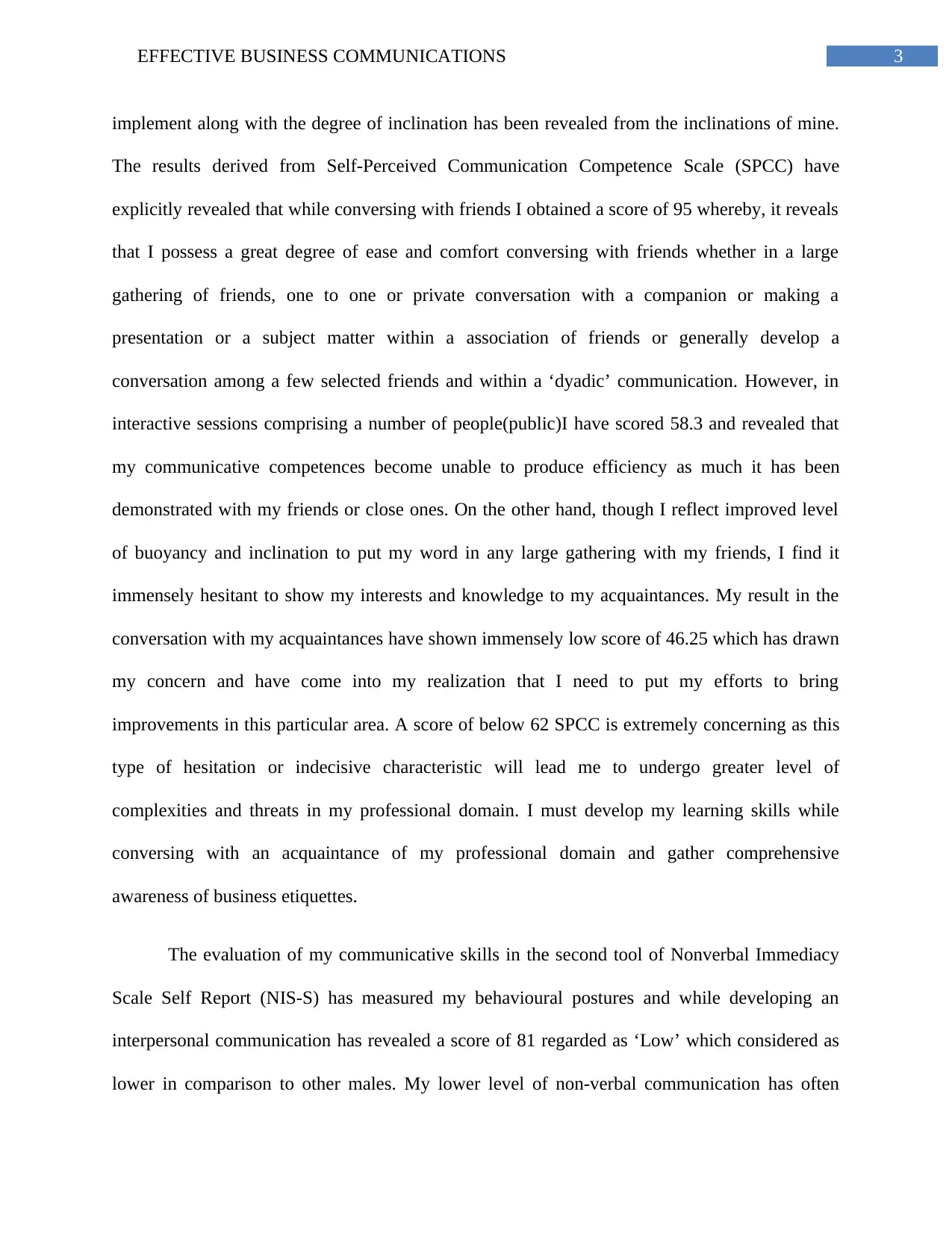
3EFFECTIVE BUSINESS COMMUNICATIONS
implement along with the degree of inclination has been revealed from the inclinations of mine.
The results derived from Self-Perceived Communication Competence Scale (SPCC) have
explicitly revealed that while conversing with friends I obtained a score of 95 whereby, it reveals
that I possess a great degree of ease and comfort conversing with friends whether in a large
gathering of friends, one to one or private conversation with a companion or making a
presentation or a subject matter within a association of friends or generally develop a
conversation among a few selected friends and within a ‘dyadic’ communication. However, in
interactive sessions comprising a number of people(public)I have scored 58.3 and revealed that
my communicative competences become unable to produce efficiency as much it has been
demonstrated with my friends or close ones. On the other hand, though I reflect improved level
of buoyancy and inclination to put my word in any large gathering with my friends, I find it
immensely hesitant to show my interests and knowledge to my acquaintances. My result in the
conversation with my acquaintances have shown immensely low score of 46.25 which has drawn
my concern and have come into my realization that I need to put my efforts to bring
improvements in this particular area. A score of below 62 SPCC is extremely concerning as this
type of hesitation or indecisive characteristic will lead me to undergo greater level of
complexities and threats in my professional domain. I must develop my learning skills while
conversing with an acquaintance of my professional domain and gather comprehensive
awareness of business etiquettes.
The evaluation of my communicative skills in the second tool of Nonverbal Immediacy
Scale Self Report (NIS-S) has measured my behavioural postures and while developing an
interpersonal communication has revealed a score of 81 regarded as ‘Low’ which considered as
lower in comparison to other males. My lower level of non-verbal communication has often
implement along with the degree of inclination has been revealed from the inclinations of mine.
The results derived from Self-Perceived Communication Competence Scale (SPCC) have
explicitly revealed that while conversing with friends I obtained a score of 95 whereby, it reveals
that I possess a great degree of ease and comfort conversing with friends whether in a large
gathering of friends, one to one or private conversation with a companion or making a
presentation or a subject matter within a association of friends or generally develop a
conversation among a few selected friends and within a ‘dyadic’ communication. However, in
interactive sessions comprising a number of people(public)I have scored 58.3 and revealed that
my communicative competences become unable to produce efficiency as much it has been
demonstrated with my friends or close ones. On the other hand, though I reflect improved level
of buoyancy and inclination to put my word in any large gathering with my friends, I find it
immensely hesitant to show my interests and knowledge to my acquaintances. My result in the
conversation with my acquaintances have shown immensely low score of 46.25 which has drawn
my concern and have come into my realization that I need to put my efforts to bring
improvements in this particular area. A score of below 62 SPCC is extremely concerning as this
type of hesitation or indecisive characteristic will lead me to undergo greater level of
complexities and threats in my professional domain. I must develop my learning skills while
conversing with an acquaintance of my professional domain and gather comprehensive
awareness of business etiquettes.
The evaluation of my communicative skills in the second tool of Nonverbal Immediacy
Scale Self Report (NIS-S) has measured my behavioural postures and while developing an
interpersonal communication has revealed a score of 81 regarded as ‘Low’ which considered as
lower in comparison to other males. My lower level of non-verbal communication has often
Secure Best Marks with AI Grader
Need help grading? Try our AI Grader for instant feedback on your assignments.
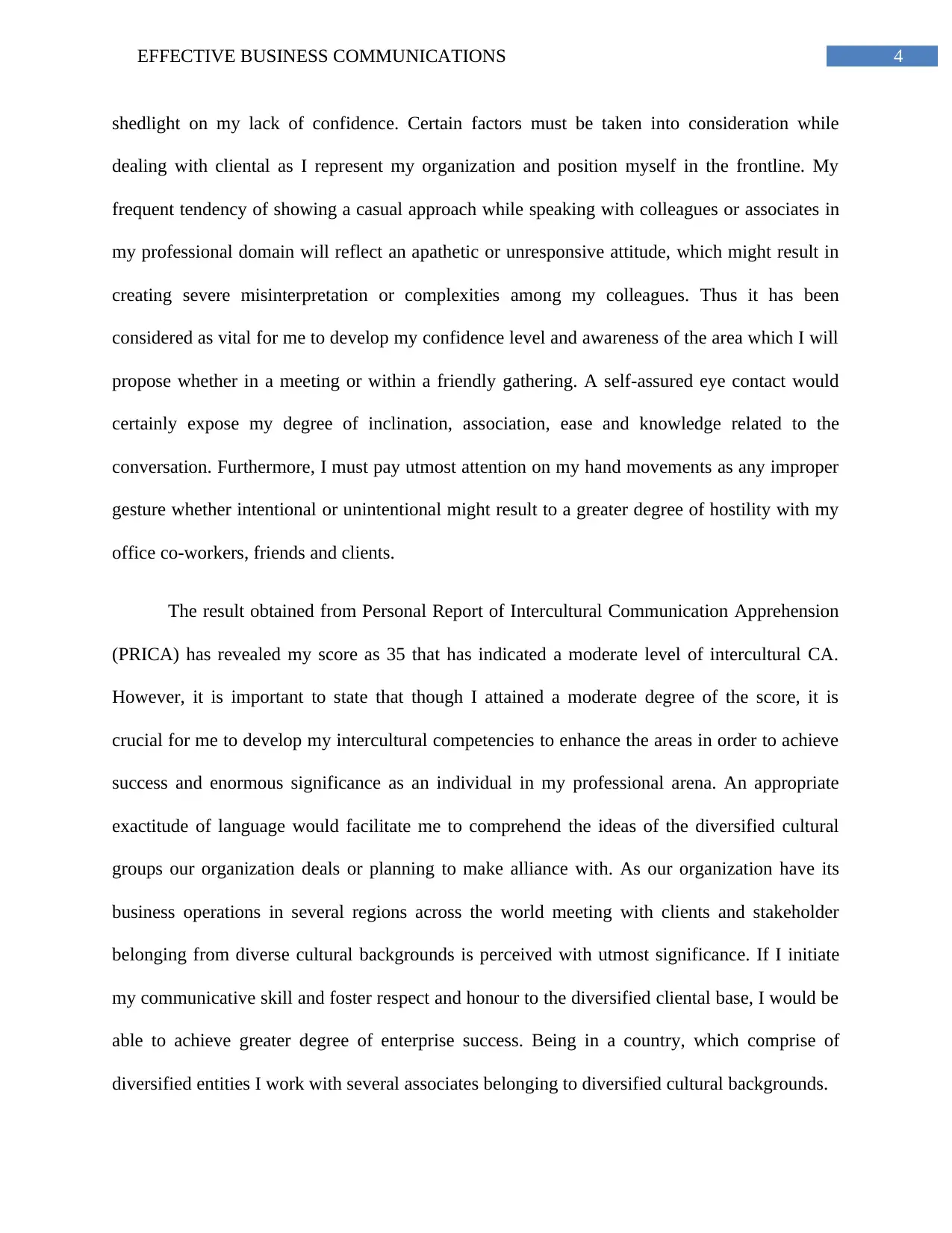
4EFFECTIVE BUSINESS COMMUNICATIONS
shedlight on my lack of confidence. Certain factors must be taken into consideration while
dealing with cliental as I represent my organization and position myself in the frontline. My
frequent tendency of showing a casual approach while speaking with colleagues or associates in
my professional domain will reflect an apathetic or unresponsive attitude, which might result in
creating severe misinterpretation or complexities among my colleagues. Thus it has been
considered as vital for me to develop my confidence level and awareness of the area which I will
propose whether in a meeting or within a friendly gathering. A self-assured eye contact would
certainly expose my degree of inclination, association, ease and knowledge related to the
conversation. Furthermore, I must pay utmost attention on my hand movements as any improper
gesture whether intentional or unintentional might result to a greater degree of hostility with my
office co-workers, friends and clients.
The result obtained from Personal Report of Intercultural Communication Apprehension
(PRICA) has revealed my score as 35 that has indicated a moderate level of intercultural CA.
However, it is important to state that though I attained a moderate degree of the score, it is
crucial for me to develop my intercultural competencies to enhance the areas in order to achieve
success and enormous significance as an individual in my professional arena. An appropriate
exactitude of language would facilitate me to comprehend the ideas of the diversified cultural
groups our organization deals or planning to make alliance with. As our organization have its
business operations in several regions across the world meeting with clients and stakeholder
belonging from diverse cultural backgrounds is perceived with utmost significance. If I initiate
my communicative skill and foster respect and honour to the diversified cliental base, I would be
able to achieve greater degree of enterprise success. Being in a country, which comprise of
diversified entities I work with several associates belonging to diversified cultural backgrounds.
shedlight on my lack of confidence. Certain factors must be taken into consideration while
dealing with cliental as I represent my organization and position myself in the frontline. My
frequent tendency of showing a casual approach while speaking with colleagues or associates in
my professional domain will reflect an apathetic or unresponsive attitude, which might result in
creating severe misinterpretation or complexities among my colleagues. Thus it has been
considered as vital for me to develop my confidence level and awareness of the area which I will
propose whether in a meeting or within a friendly gathering. A self-assured eye contact would
certainly expose my degree of inclination, association, ease and knowledge related to the
conversation. Furthermore, I must pay utmost attention on my hand movements as any improper
gesture whether intentional or unintentional might result to a greater degree of hostility with my
office co-workers, friends and clients.
The result obtained from Personal Report of Intercultural Communication Apprehension
(PRICA) has revealed my score as 35 that has indicated a moderate level of intercultural CA.
However, it is important to state that though I attained a moderate degree of the score, it is
crucial for me to develop my intercultural competencies to enhance the areas in order to achieve
success and enormous significance as an individual in my professional arena. An appropriate
exactitude of language would facilitate me to comprehend the ideas of the diversified cultural
groups our organization deals or planning to make alliance with. As our organization have its
business operations in several regions across the world meeting with clients and stakeholder
belonging from diverse cultural backgrounds is perceived with utmost significance. If I initiate
my communicative skill and foster respect and honour to the diversified cliental base, I would be
able to achieve greater degree of enterprise success. Being in a country, which comprise of
diversified entities I work with several associates belonging to diversified cultural backgrounds.
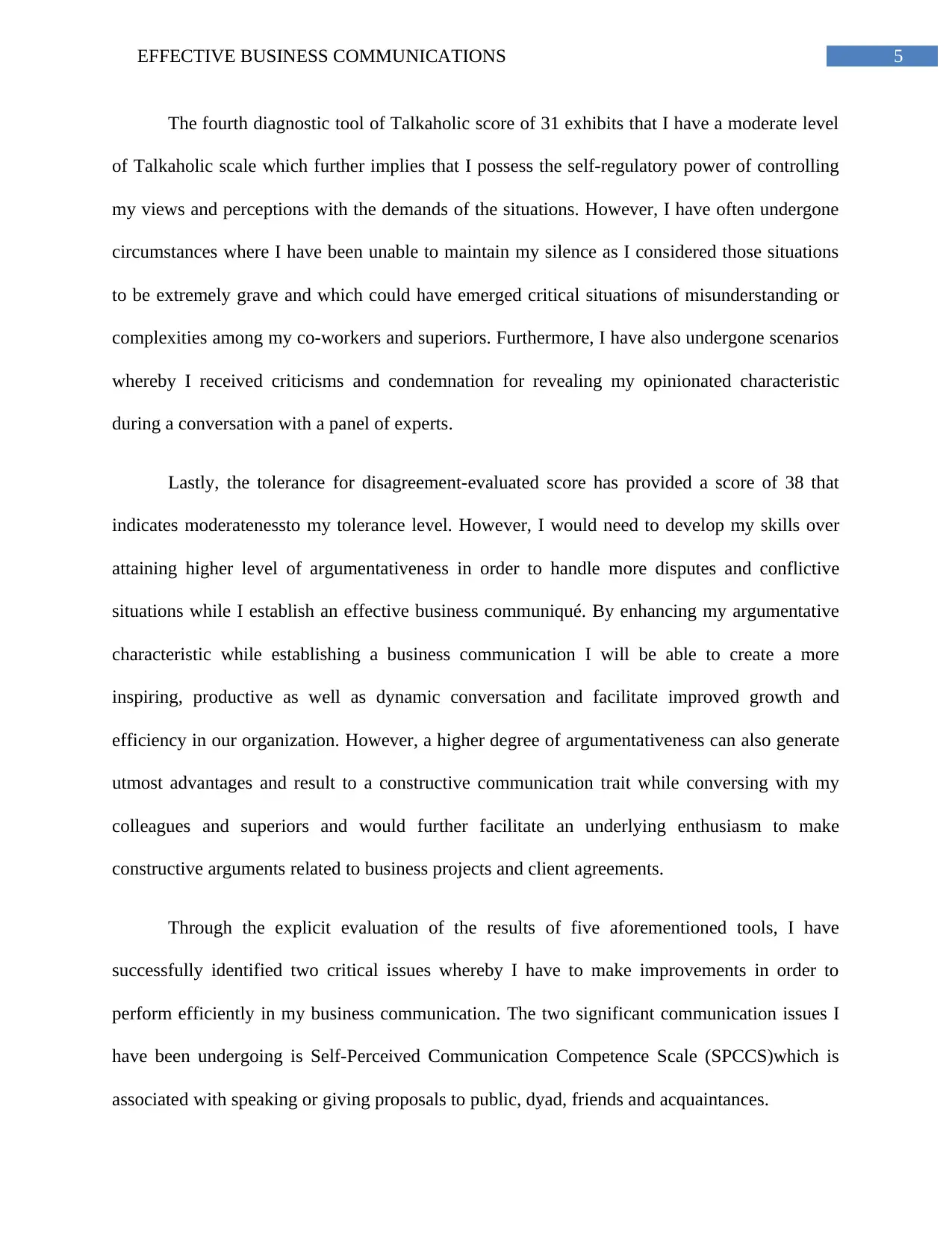
5EFFECTIVE BUSINESS COMMUNICATIONS
The fourth diagnostic tool of Talkaholic score of 31 exhibits that I have a moderate level
of Talkaholic scale which further implies that I possess the self-regulatory power of controlling
my views and perceptions with the demands of the situations. However, I have often undergone
circumstances where I have been unable to maintain my silence as I considered those situations
to be extremely grave and which could have emerged critical situations of misunderstanding or
complexities among my co-workers and superiors. Furthermore, I have also undergone scenarios
whereby I received criticisms and condemnation for revealing my opinionated characteristic
during a conversation with a panel of experts.
Lastly, the tolerance for disagreement-evaluated score has provided a score of 38 that
indicates moderatenessto my tolerance level. However, I would need to develop my skills over
attaining higher level of argumentativeness in order to handle more disputes and conflictive
situations while I establish an effective business communiqué. By enhancing my argumentative
characteristic while establishing a business communication I will be able to create a more
inspiring, productive as well as dynamic conversation and facilitate improved growth and
efficiency in our organization. However, a higher degree of argumentativeness can also generate
utmost advantages and result to a constructive communication trait while conversing with my
colleagues and superiors and would further facilitate an underlying enthusiasm to make
constructive arguments related to business projects and client agreements.
Through the explicit evaluation of the results of five aforementioned tools, I have
successfully identified two critical issues whereby I have to make improvements in order to
perform efficiently in my business communication. The two significant communication issues I
have been undergoing is Self-Perceived Communication Competence Scale (SPCCS)which is
associated with speaking or giving proposals to public, dyad, friends and acquaintances.
The fourth diagnostic tool of Talkaholic score of 31 exhibits that I have a moderate level
of Talkaholic scale which further implies that I possess the self-regulatory power of controlling
my views and perceptions with the demands of the situations. However, I have often undergone
circumstances where I have been unable to maintain my silence as I considered those situations
to be extremely grave and which could have emerged critical situations of misunderstanding or
complexities among my co-workers and superiors. Furthermore, I have also undergone scenarios
whereby I received criticisms and condemnation for revealing my opinionated characteristic
during a conversation with a panel of experts.
Lastly, the tolerance for disagreement-evaluated score has provided a score of 38 that
indicates moderatenessto my tolerance level. However, I would need to develop my skills over
attaining higher level of argumentativeness in order to handle more disputes and conflictive
situations while I establish an effective business communiqué. By enhancing my argumentative
characteristic while establishing a business communication I will be able to create a more
inspiring, productive as well as dynamic conversation and facilitate improved growth and
efficiency in our organization. However, a higher degree of argumentativeness can also generate
utmost advantages and result to a constructive communication trait while conversing with my
colleagues and superiors and would further facilitate an underlying enthusiasm to make
constructive arguments related to business projects and client agreements.
Through the explicit evaluation of the results of five aforementioned tools, I have
successfully identified two critical issues whereby I have to make improvements in order to
perform efficiently in my business communication. The two significant communication issues I
have been undergoing is Self-Perceived Communication Competence Scale (SPCCS)which is
associated with speaking or giving proposals to public, dyad, friends and acquaintances.
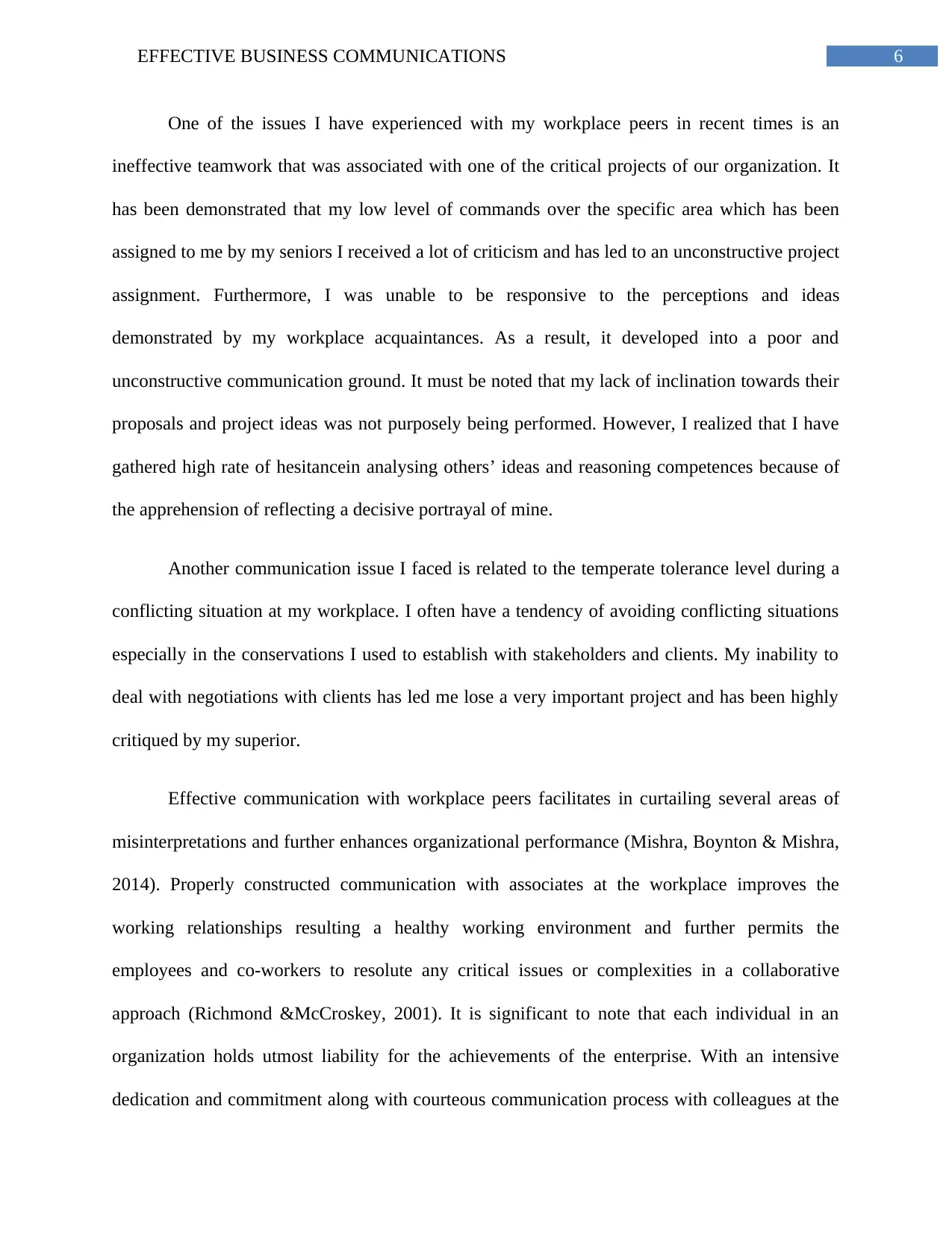
6EFFECTIVE BUSINESS COMMUNICATIONS
One of the issues I have experienced with my workplace peers in recent times is an
ineffective teamwork that was associated with one of the critical projects of our organization. It
has been demonstrated that my low level of commands over the specific area which has been
assigned to me by my seniors I received a lot of criticism and has led to an unconstructive project
assignment. Furthermore, I was unable to be responsive to the perceptions and ideas
demonstrated by my workplace acquaintances. As a result, it developed into a poor and
unconstructive communication ground. It must be noted that my lack of inclination towards their
proposals and project ideas was not purposely being performed. However, I realized that I have
gathered high rate of hesitancein analysing others’ ideas and reasoning competences because of
the apprehension of reflecting a decisive portrayal of mine.
Another communication issue I faced is related to the temperate tolerance level during a
conflicting situation at my workplace. I often have a tendency of avoiding conflicting situations
especially in the conservations I used to establish with stakeholders and clients. My inability to
deal with negotiations with clients has led me lose a very important project and has been highly
critiqued by my superior.
Effective communication with workplace peers facilitates in curtailing several areas of
misinterpretations and further enhances organizational performance (Mishra, Boynton & Mishra,
2014). Properly constructed communication with associates at the workplace improves the
working relationships resulting a healthy working environment and further permits the
employees and co-workers to resolute any critical issues or complexities in a collaborative
approach (Richmond &McCroskey, 2001). It is significant to note that each individual in an
organization holds utmost liability for the achievements of the enterprise. With an intensive
dedication and commitment along with courteous communication process with colleagues at the
One of the issues I have experienced with my workplace peers in recent times is an
ineffective teamwork that was associated with one of the critical projects of our organization. It
has been demonstrated that my low level of commands over the specific area which has been
assigned to me by my seniors I received a lot of criticism and has led to an unconstructive project
assignment. Furthermore, I was unable to be responsive to the perceptions and ideas
demonstrated by my workplace acquaintances. As a result, it developed into a poor and
unconstructive communication ground. It must be noted that my lack of inclination towards their
proposals and project ideas was not purposely being performed. However, I realized that I have
gathered high rate of hesitancein analysing others’ ideas and reasoning competences because of
the apprehension of reflecting a decisive portrayal of mine.
Another communication issue I faced is related to the temperate tolerance level during a
conflicting situation at my workplace. I often have a tendency of avoiding conflicting situations
especially in the conservations I used to establish with stakeholders and clients. My inability to
deal with negotiations with clients has led me lose a very important project and has been highly
critiqued by my superior.
Effective communication with workplace peers facilitates in curtailing several areas of
misinterpretations and further enhances organizational performance (Mishra, Boynton & Mishra,
2014). Properly constructed communication with associates at the workplace improves the
working relationships resulting a healthy working environment and further permits the
employees and co-workers to resolute any critical issues or complexities in a collaborative
approach (Richmond &McCroskey, 2001). It is significant to note that each individual in an
organization holds utmost liability for the achievements of the enterprise. With an intensive
dedication and commitment along with courteous communication process with colleagues at the
Paraphrase This Document
Need a fresh take? Get an instant paraphrase of this document with our AI Paraphraser
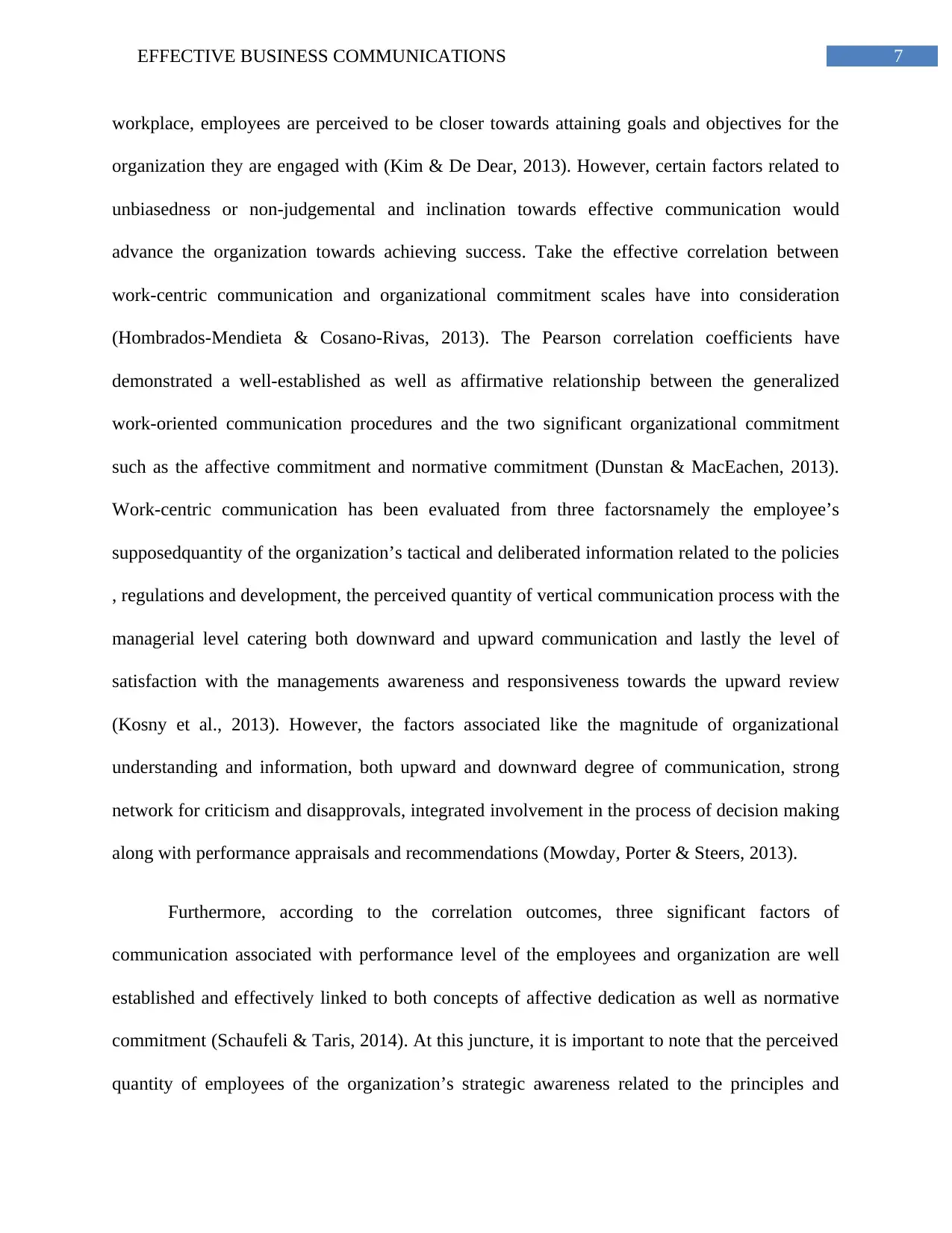
7EFFECTIVE BUSINESS COMMUNICATIONS
workplace, employees are perceived to be closer towards attaining goals and objectives for the
organization they are engaged with (Kim & De Dear, 2013). However, certain factors related to
unbiasedness or non-judgemental and inclination towards effective communication would
advance the organization towards achieving success. Take the effective correlation between
work-centric communication and organizational commitment scales have into consideration
(Hombrados-Mendieta & Cosano-Rivas, 2013). The Pearson correlation coefficients have
demonstrated a well-established as well as affirmative relationship between the generalized
work-oriented communication procedures and the two significant organizational commitment
such as the affective commitment and normative commitment (Dunstan & MacEachen, 2013).
Work-centric communication has been evaluated from three factorsnamely the employee’s
supposedquantity of the organization’s tactical and deliberated information related to the policies
, regulations and development, the perceived quantity of vertical communication process with the
managerial level catering both downward and upward communication and lastly the level of
satisfaction with the managements awareness and responsiveness towards the upward review
(Kosny et al., 2013). However, the factors associated like the magnitude of organizational
understanding and information, both upward and downward degree of communication, strong
network for criticism and disapprovals, integrated involvement in the process of decision making
along with performance appraisals and recommendations (Mowday, Porter & Steers, 2013).
Furthermore, according to the correlation outcomes, three significant factors of
communication associated with performance level of the employees and organization are well
established and effectively linked to both concepts of affective dedication as well as normative
commitment (Schaufeli & Taris, 2014). At this juncture, it is important to note that the perceived
quantity of employees of the organization’s strategic awareness related to the principles and
workplace, employees are perceived to be closer towards attaining goals and objectives for the
organization they are engaged with (Kim & De Dear, 2013). However, certain factors related to
unbiasedness or non-judgemental and inclination towards effective communication would
advance the organization towards achieving success. Take the effective correlation between
work-centric communication and organizational commitment scales have into consideration
(Hombrados-Mendieta & Cosano-Rivas, 2013). The Pearson correlation coefficients have
demonstrated a well-established as well as affirmative relationship between the generalized
work-oriented communication procedures and the two significant organizational commitment
such as the affective commitment and normative commitment (Dunstan & MacEachen, 2013).
Work-centric communication has been evaluated from three factorsnamely the employee’s
supposedquantity of the organization’s tactical and deliberated information related to the policies
, regulations and development, the perceived quantity of vertical communication process with the
managerial level catering both downward and upward communication and lastly the level of
satisfaction with the managements awareness and responsiveness towards the upward review
(Kosny et al., 2013). However, the factors associated like the magnitude of organizational
understanding and information, both upward and downward degree of communication, strong
network for criticism and disapprovals, integrated involvement in the process of decision making
along with performance appraisals and recommendations (Mowday, Porter & Steers, 2013).
Furthermore, according to the correlation outcomes, three significant factors of
communication associated with performance level of the employees and organization are well
established and effectively linked to both concepts of affective dedication as well as normative
commitment (Schaufeli & Taris, 2014). At this juncture, it is important to note that the perceived
quantity of employees of the organization’s strategic awareness related to the principles and
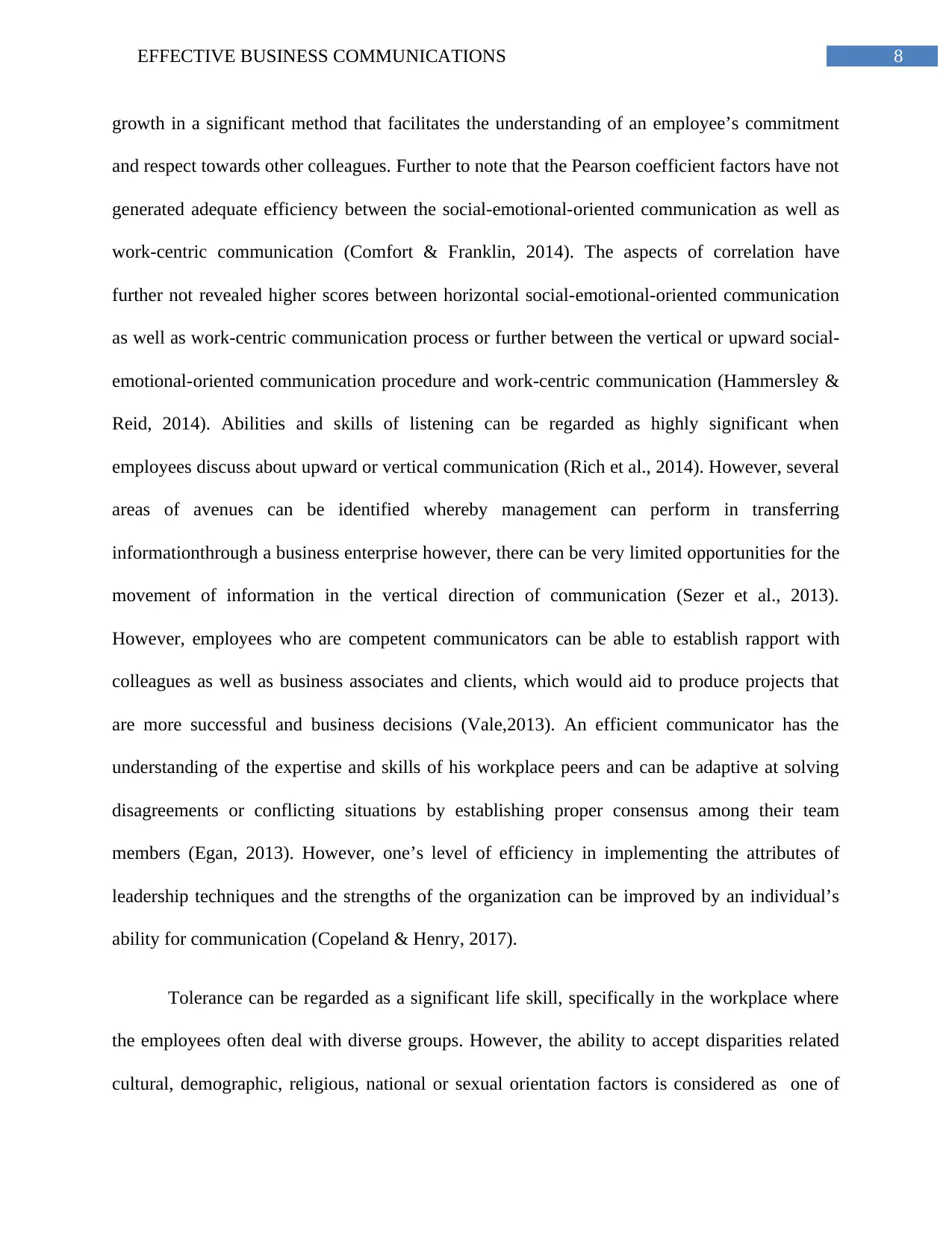
8EFFECTIVE BUSINESS COMMUNICATIONS
growth in a significant method that facilitates the understanding of an employee’s commitment
and respect towards other colleagues. Further to note that the Pearson coefficient factors have not
generated adequate efficiency between the social-emotional-oriented communication as well as
work-centric communication (Comfort & Franklin, 2014). The aspects of correlation have
further not revealed higher scores between horizontal social-emotional-oriented communication
as well as work-centric communication process or further between the vertical or upward social-
emotional-oriented communication procedure and work-centric communication (Hammersley &
Reid, 2014). Abilities and skills of listening can be regarded as highly significant when
employees discuss about upward or vertical communication (Rich et al., 2014). However, several
areas of avenues can be identified whereby management can perform in transferring
informationthrough a business enterprise however, there can be very limited opportunities for the
movement of information in the vertical direction of communication (Sezer et al., 2013).
However, employees who are competent communicators can be able to establish rapport with
colleagues as well as business associates and clients, which would aid to produce projects that
are more successful and business decisions (Vale,2013). An efficient communicator has the
understanding of the expertise and skills of his workplace peers and can be adaptive at solving
disagreements or conflicting situations by establishing proper consensus among their team
members (Egan, 2013). However, one’s level of efficiency in implementing the attributes of
leadership techniques and the strengths of the organization can be improved by an individual’s
ability for communication (Copeland & Henry, 2017).
Tolerance can be regarded as a significant life skill, specifically in the workplace where
the employees often deal with diverse groups. However, the ability to accept disparities related
cultural, demographic, religious, national or sexual orientation factors is considered as one of
growth in a significant method that facilitates the understanding of an employee’s commitment
and respect towards other colleagues. Further to note that the Pearson coefficient factors have not
generated adequate efficiency between the social-emotional-oriented communication as well as
work-centric communication (Comfort & Franklin, 2014). The aspects of correlation have
further not revealed higher scores between horizontal social-emotional-oriented communication
as well as work-centric communication process or further between the vertical or upward social-
emotional-oriented communication procedure and work-centric communication (Hammersley &
Reid, 2014). Abilities and skills of listening can be regarded as highly significant when
employees discuss about upward or vertical communication (Rich et al., 2014). However, several
areas of avenues can be identified whereby management can perform in transferring
informationthrough a business enterprise however, there can be very limited opportunities for the
movement of information in the vertical direction of communication (Sezer et al., 2013).
However, employees who are competent communicators can be able to establish rapport with
colleagues as well as business associates and clients, which would aid to produce projects that
are more successful and business decisions (Vale,2013). An efficient communicator has the
understanding of the expertise and skills of his workplace peers and can be adaptive at solving
disagreements or conflicting situations by establishing proper consensus among their team
members (Egan, 2013). However, one’s level of efficiency in implementing the attributes of
leadership techniques and the strengths of the organization can be improved by an individual’s
ability for communication (Copeland & Henry, 2017).
Tolerance can be regarded as a significant life skill, specifically in the workplace where
the employees often deal with diverse groups. However, the ability to accept disparities related
cultural, demographic, religious, national or sexual orientation factors is considered as one of
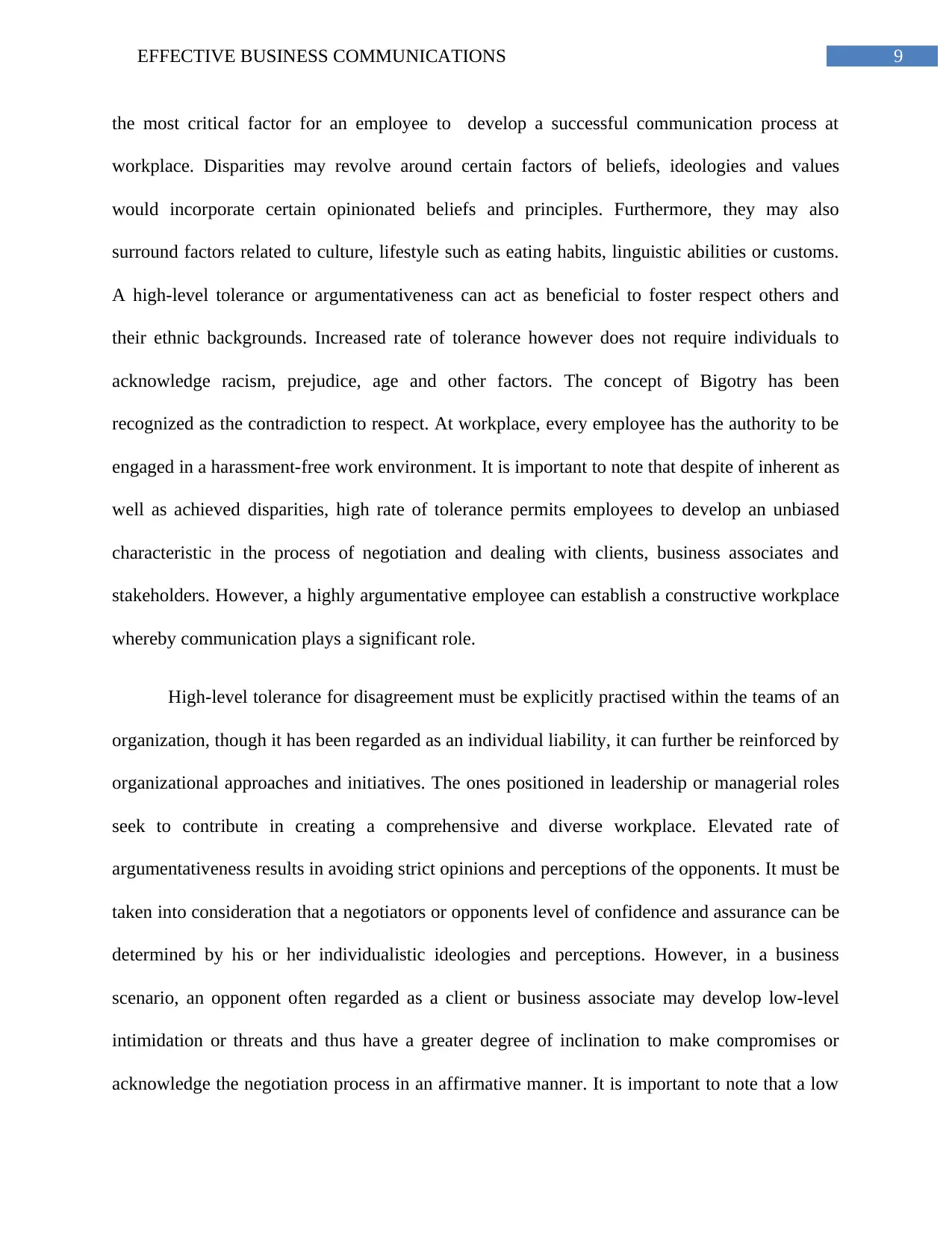
9EFFECTIVE BUSINESS COMMUNICATIONS
the most critical factor for an employee to develop a successful communication process at
workplace. Disparities may revolve around certain factors of beliefs, ideologies and values
would incorporate certain opinionated beliefs and principles. Furthermore, they may also
surround factors related to culture, lifestyle such as eating habits, linguistic abilities or customs.
A high-level tolerance or argumentativeness can act as beneficial to foster respect others and
their ethnic backgrounds. Increased rate of tolerance however does not require individuals to
acknowledge racism, prejudice, age and other factors. The concept of Bigotry has been
recognized as the contradiction to respect. At workplace, every employee has the authority to be
engaged in a harassment-free work environment. It is important to note that despite of inherent as
well as achieved disparities, high rate of tolerance permits employees to develop an unbiased
characteristic in the process of negotiation and dealing with clients, business associates and
stakeholders. However, a highly argumentative employee can establish a constructive workplace
whereby communication plays a significant role.
High-level tolerance for disagreement must be explicitly practised within the teams of an
organization, though it has been regarded as an individual liability, it can further be reinforced by
organizational approaches and initiatives. The ones positioned in leadership or managerial roles
seek to contribute in creating a comprehensive and diverse workplace. Elevated rate of
argumentativeness results in avoiding strict opinions and perceptions of the opponents. It must be
taken into consideration that a negotiators or opponents level of confidence and assurance can be
determined by his or her individualistic ideologies and perceptions. However, in a business
scenario, an opponent often regarded as a client or business associate may develop low-level
intimidation or threats and thus have a greater degree of inclination to make compromises or
acknowledge the negotiation process in an affirmative manner. It is important to note that a low
the most critical factor for an employee to develop a successful communication process at
workplace. Disparities may revolve around certain factors of beliefs, ideologies and values
would incorporate certain opinionated beliefs and principles. Furthermore, they may also
surround factors related to culture, lifestyle such as eating habits, linguistic abilities or customs.
A high-level tolerance or argumentativeness can act as beneficial to foster respect others and
their ethnic backgrounds. Increased rate of tolerance however does not require individuals to
acknowledge racism, prejudice, age and other factors. The concept of Bigotry has been
recognized as the contradiction to respect. At workplace, every employee has the authority to be
engaged in a harassment-free work environment. It is important to note that despite of inherent as
well as achieved disparities, high rate of tolerance permits employees to develop an unbiased
characteristic in the process of negotiation and dealing with clients, business associates and
stakeholders. However, a highly argumentative employee can establish a constructive workplace
whereby communication plays a significant role.
High-level tolerance for disagreement must be explicitly practised within the teams of an
organization, though it has been regarded as an individual liability, it can further be reinforced by
organizational approaches and initiatives. The ones positioned in leadership or managerial roles
seek to contribute in creating a comprehensive and diverse workplace. Elevated rate of
argumentativeness results in avoiding strict opinions and perceptions of the opponents. It must be
taken into consideration that a negotiators or opponents level of confidence and assurance can be
determined by his or her individualistic ideologies and perceptions. However, in a business
scenario, an opponent often regarded as a client or business associate may develop low-level
intimidation or threats and thus have a greater degree of inclination to make compromises or
acknowledge the negotiation process in an affirmative manner. It is important to note that a low
Secure Best Marks with AI Grader
Need help grading? Try our AI Grader for instant feedback on your assignments.
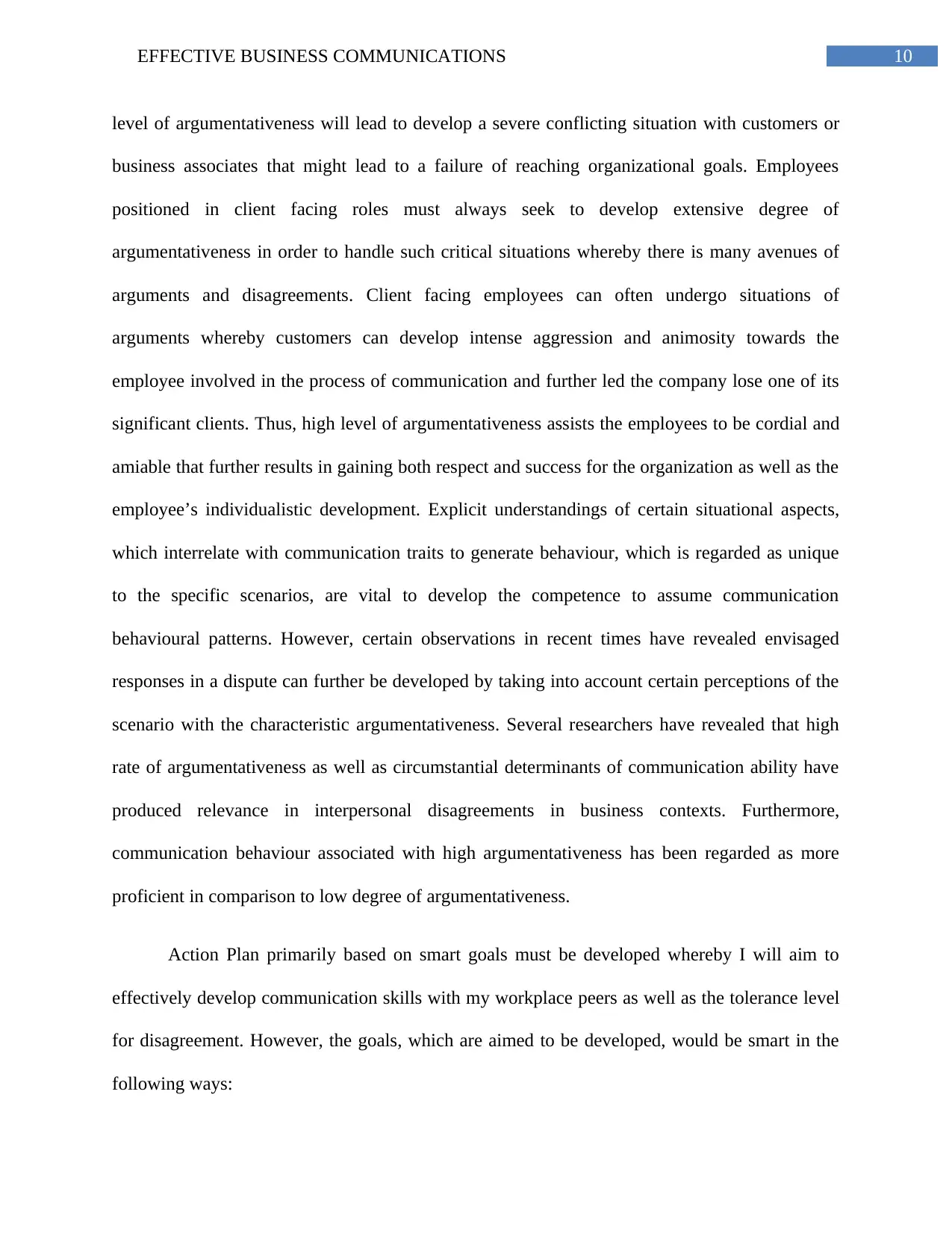
10EFFECTIVE BUSINESS COMMUNICATIONS
level of argumentativeness will lead to develop a severe conflicting situation with customers or
business associates that might lead to a failure of reaching organizational goals. Employees
positioned in client facing roles must always seek to develop extensive degree of
argumentativeness in order to handle such critical situations whereby there is many avenues of
arguments and disagreements. Client facing employees can often undergo situations of
arguments whereby customers can develop intense aggression and animosity towards the
employee involved in the process of communication and further led the company lose one of its
significant clients. Thus, high level of argumentativeness assists the employees to be cordial and
amiable that further results in gaining both respect and success for the organization as well as the
employee’s individualistic development. Explicit understandings of certain situational aspects,
which interrelate with communication traits to generate behaviour, which is regarded as unique
to the specific scenarios, are vital to develop the competence to assume communication
behavioural patterns. However, certain observations in recent times have revealed envisaged
responses in a dispute can further be developed by taking into account certain perceptions of the
scenario with the characteristic argumentativeness. Several researchers have revealed that high
rate of argumentativeness as well as circumstantial determinants of communication ability have
produced relevance in interpersonal disagreements in business contexts. Furthermore,
communication behaviour associated with high argumentativeness has been regarded as more
proficient in comparison to low degree of argumentativeness.
Action Plan primarily based on smart goals must be developed whereby I will aim to
effectively develop communication skills with my workplace peers as well as the tolerance level
for disagreement. However, the goals, which are aimed to be developed, would be smart in the
following ways:
level of argumentativeness will lead to develop a severe conflicting situation with customers or
business associates that might lead to a failure of reaching organizational goals. Employees
positioned in client facing roles must always seek to develop extensive degree of
argumentativeness in order to handle such critical situations whereby there is many avenues of
arguments and disagreements. Client facing employees can often undergo situations of
arguments whereby customers can develop intense aggression and animosity towards the
employee involved in the process of communication and further led the company lose one of its
significant clients. Thus, high level of argumentativeness assists the employees to be cordial and
amiable that further results in gaining both respect and success for the organization as well as the
employee’s individualistic development. Explicit understandings of certain situational aspects,
which interrelate with communication traits to generate behaviour, which is regarded as unique
to the specific scenarios, are vital to develop the competence to assume communication
behavioural patterns. However, certain observations in recent times have revealed envisaged
responses in a dispute can further be developed by taking into account certain perceptions of the
scenario with the characteristic argumentativeness. Several researchers have revealed that high
rate of argumentativeness as well as circumstantial determinants of communication ability have
produced relevance in interpersonal disagreements in business contexts. Furthermore,
communication behaviour associated with high argumentativeness has been regarded as more
proficient in comparison to low degree of argumentativeness.
Action Plan primarily based on smart goals must be developed whereby I will aim to
effectively develop communication skills with my workplace peers as well as the tolerance level
for disagreement. However, the goals, which are aimed to be developed, would be smart in the
following ways:
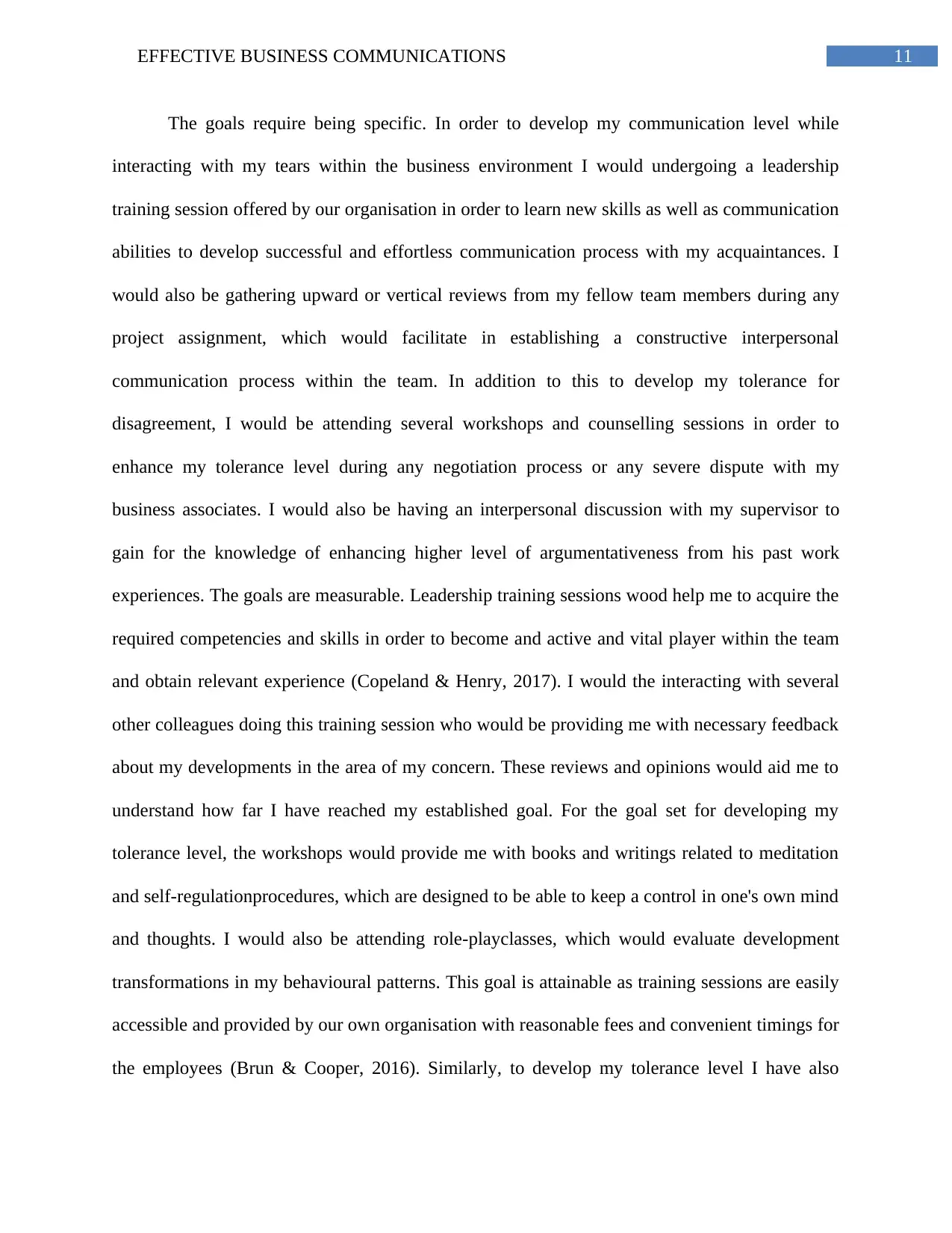
11EFFECTIVE BUSINESS COMMUNICATIONS
The goals require being specific. In order to develop my communication level while
interacting with my tears within the business environment I would undergoing a leadership
training session offered by our organisation in order to learn new skills as well as communication
abilities to develop successful and effortless communication process with my acquaintances. I
would also be gathering upward or vertical reviews from my fellow team members during any
project assignment, which would facilitate in establishing a constructive interpersonal
communication process within the team. In addition to this to develop my tolerance for
disagreement, I would be attending several workshops and counselling sessions in order to
enhance my tolerance level during any negotiation process or any severe dispute with my
business associates. I would also be having an interpersonal discussion with my supervisor to
gain for the knowledge of enhancing higher level of argumentativeness from his past work
experiences. The goals are measurable. Leadership training sessions wood help me to acquire the
required competencies and skills in order to become and active and vital player within the team
and obtain relevant experience (Copeland & Henry, 2017). I would the interacting with several
other colleagues doing this training session who would be providing me with necessary feedback
about my developments in the area of my concern. These reviews and opinions would aid me to
understand how far I have reached my established goal. For the goal set for developing my
tolerance level, the workshops would provide me with books and writings related to meditation
and self-regulationprocedures, which are designed to be able to keep a control in one's own mind
and thoughts. I would also be attending role-playclasses, which would evaluate development
transformations in my behavioural patterns. This goal is attainable as training sessions are easily
accessible and provided by our own organisation with reasonable fees and convenient timings for
the employees (Brun & Cooper, 2016). Similarly, to develop my tolerance level I have also
The goals require being specific. In order to develop my communication level while
interacting with my tears within the business environment I would undergoing a leadership
training session offered by our organisation in order to learn new skills as well as communication
abilities to develop successful and effortless communication process with my acquaintances. I
would also be gathering upward or vertical reviews from my fellow team members during any
project assignment, which would facilitate in establishing a constructive interpersonal
communication process within the team. In addition to this to develop my tolerance for
disagreement, I would be attending several workshops and counselling sessions in order to
enhance my tolerance level during any negotiation process or any severe dispute with my
business associates. I would also be having an interpersonal discussion with my supervisor to
gain for the knowledge of enhancing higher level of argumentativeness from his past work
experiences. The goals are measurable. Leadership training sessions wood help me to acquire the
required competencies and skills in order to become and active and vital player within the team
and obtain relevant experience (Copeland & Henry, 2017). I would the interacting with several
other colleagues doing this training session who would be providing me with necessary feedback
about my developments in the area of my concern. These reviews and opinions would aid me to
understand how far I have reached my established goal. For the goal set for developing my
tolerance level, the workshops would provide me with books and writings related to meditation
and self-regulationprocedures, which are designed to be able to keep a control in one's own mind
and thoughts. I would also be attending role-playclasses, which would evaluate development
transformations in my behavioural patterns. This goal is attainable as training sessions are easily
accessible and provided by our own organisation with reasonable fees and convenient timings for
the employees (Brun & Cooper, 2016). Similarly, to develop my tolerance level I have also
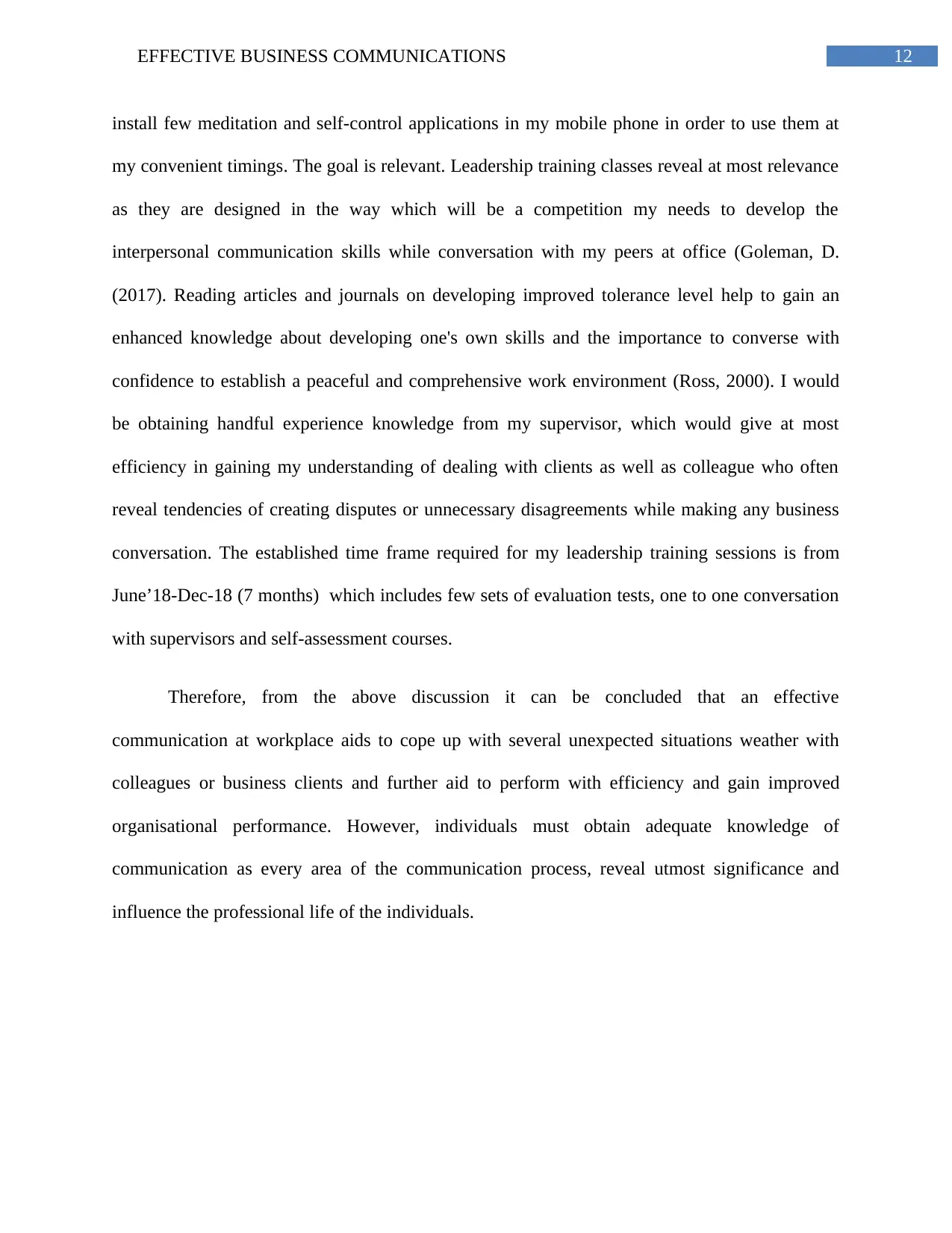
12EFFECTIVE BUSINESS COMMUNICATIONS
install few meditation and self-control applications in my mobile phone in order to use them at
my convenient timings. The goal is relevant. Leadership training classes reveal at most relevance
as they are designed in the way which will be a competition my needs to develop the
interpersonal communication skills while conversation with my peers at office (Goleman, D.
(2017). Reading articles and journals on developing improved tolerance level help to gain an
enhanced knowledge about developing one's own skills and the importance to converse with
confidence to establish a peaceful and comprehensive work environment (Ross, 2000). I would
be obtaining handful experience knowledge from my supervisor, which would give at most
efficiency in gaining my understanding of dealing with clients as well as colleague who often
reveal tendencies of creating disputes or unnecessary disagreements while making any business
conversation. The established time frame required for my leadership training sessions is from
June’18-Dec-18 (7 months) which includes few sets of evaluation tests, one to one conversation
with supervisors and self-assessment courses.
Therefore, from the above discussion it can be concluded that an effective
communication at workplace aids to cope up with several unexpected situations weather with
colleagues or business clients and further aid to perform with efficiency and gain improved
organisational performance. However, individuals must obtain adequate knowledge of
communication as every area of the communication process, reveal utmost significance and
influence the professional life of the individuals.
install few meditation and self-control applications in my mobile phone in order to use them at
my convenient timings. The goal is relevant. Leadership training classes reveal at most relevance
as they are designed in the way which will be a competition my needs to develop the
interpersonal communication skills while conversation with my peers at office (Goleman, D.
(2017). Reading articles and journals on developing improved tolerance level help to gain an
enhanced knowledge about developing one's own skills and the importance to converse with
confidence to establish a peaceful and comprehensive work environment (Ross, 2000). I would
be obtaining handful experience knowledge from my supervisor, which would give at most
efficiency in gaining my understanding of dealing with clients as well as colleague who often
reveal tendencies of creating disputes or unnecessary disagreements while making any business
conversation. The established time frame required for my leadership training sessions is from
June’18-Dec-18 (7 months) which includes few sets of evaluation tests, one to one conversation
with supervisors and self-assessment courses.
Therefore, from the above discussion it can be concluded that an effective
communication at workplace aids to cope up with several unexpected situations weather with
colleagues or business clients and further aid to perform with efficiency and gain improved
organisational performance. However, individuals must obtain adequate knowledge of
communication as every area of the communication process, reveal utmost significance and
influence the professional life of the individuals.
Paraphrase This Document
Need a fresh take? Get an instant paraphrase of this document with our AI Paraphraser
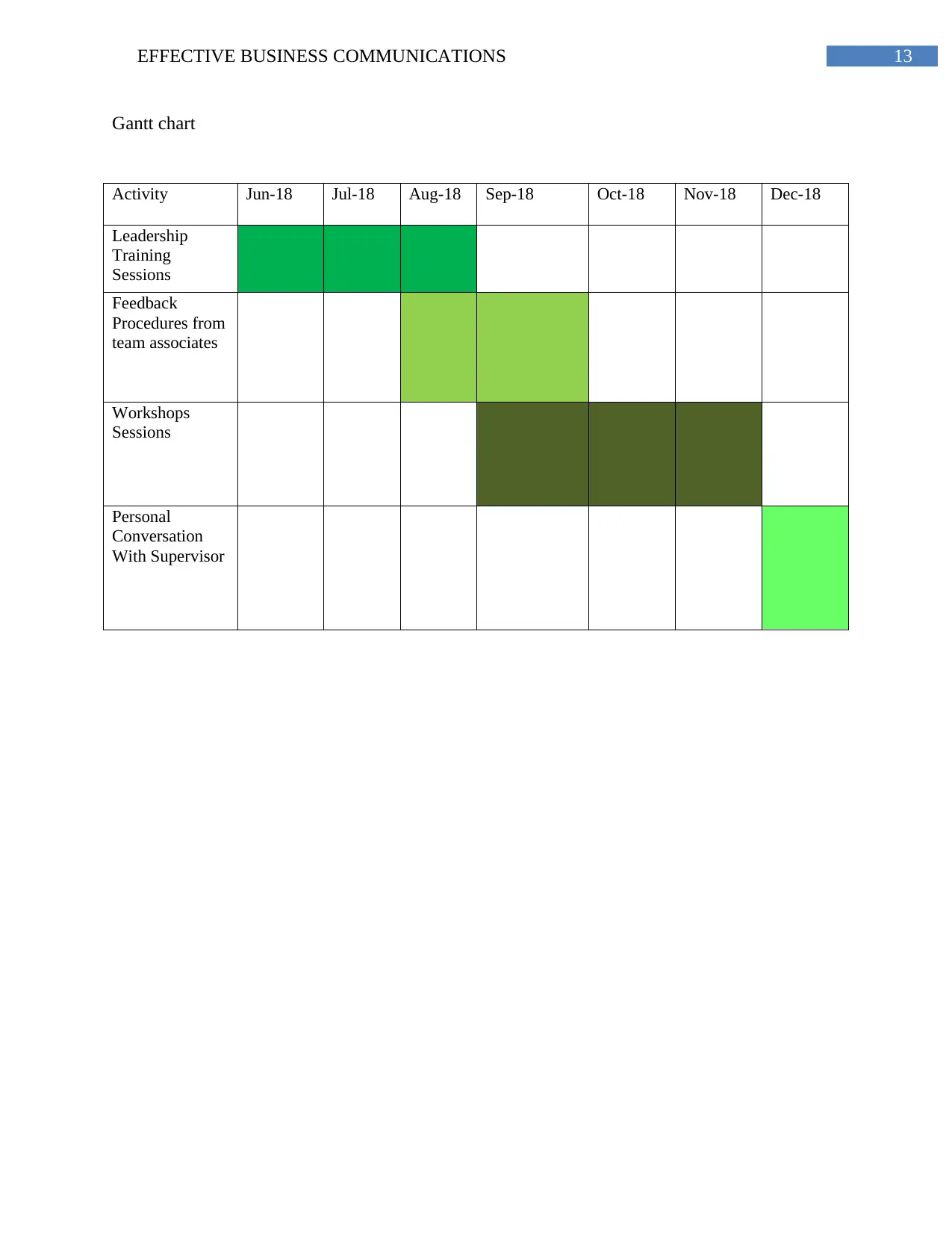
13EFFECTIVE BUSINESS COMMUNICATIONS
Gantt chart
Activity Jun-18 Jul-18 Aug-18 Sep-18 Oct-18 Nov-18 Dec-18
Leadership
Training
Sessions
Feedback
Procedures from
team associates
Workshops
Sessions
Personal
Conversation
With Supervisor
Gantt chart
Activity Jun-18 Jul-18 Aug-18 Sep-18 Oct-18 Nov-18 Dec-18
Leadership
Training
Sessions
Feedback
Procedures from
team associates
Workshops
Sessions
Personal
Conversation
With Supervisor
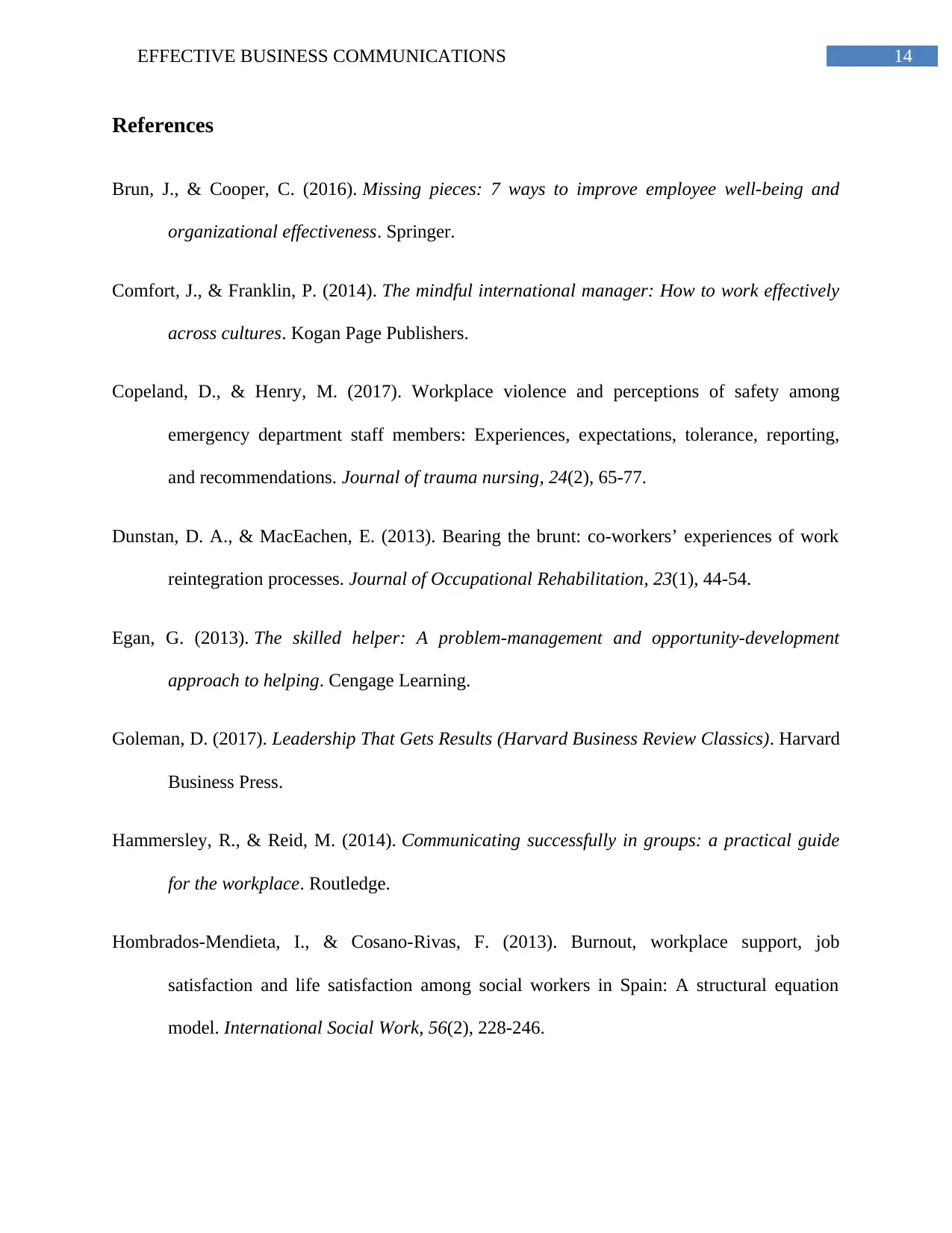
14EFFECTIVE BUSINESS COMMUNICATIONS
References
Brun, J., & Cooper, C. (2016). Missing pieces: 7 ways to improve employee well-being and
organizational effectiveness. Springer.
Comfort, J., & Franklin, P. (2014). The mindful international manager: How to work effectively
across cultures. Kogan Page Publishers.
Copeland, D., & Henry, M. (2017). Workplace violence and perceptions of safety among
emergency department staff members: Experiences, expectations, tolerance, reporting,
and recommendations. Journal of trauma nursing, 24(2), 65-77.
Dunstan, D. A., & MacEachen, E. (2013). Bearing the brunt: co-workers’ experiences of work
reintegration processes. Journal of Occupational Rehabilitation, 23(1), 44-54.
Egan, G. (2013). The skilled helper: A problem-management and opportunity-development
approach to helping. Cengage Learning.
Goleman, D. (2017). Leadership That Gets Results (Harvard Business Review Classics). Harvard
Business Press.
Hammersley, R., & Reid, M. (2014). Communicating successfully in groups: a practical guide
for the workplace. Routledge.
Hombrados-Mendieta, I., & Cosano-Rivas, F. (2013). Burnout, workplace support, job
satisfaction and life satisfaction among social workers in Spain: A structural equation
model. International Social Work, 56(2), 228-246.
References
Brun, J., & Cooper, C. (2016). Missing pieces: 7 ways to improve employee well-being and
organizational effectiveness. Springer.
Comfort, J., & Franklin, P. (2014). The mindful international manager: How to work effectively
across cultures. Kogan Page Publishers.
Copeland, D., & Henry, M. (2017). Workplace violence and perceptions of safety among
emergency department staff members: Experiences, expectations, tolerance, reporting,
and recommendations. Journal of trauma nursing, 24(2), 65-77.
Dunstan, D. A., & MacEachen, E. (2013). Bearing the brunt: co-workers’ experiences of work
reintegration processes. Journal of Occupational Rehabilitation, 23(1), 44-54.
Egan, G. (2013). The skilled helper: A problem-management and opportunity-development
approach to helping. Cengage Learning.
Goleman, D. (2017). Leadership That Gets Results (Harvard Business Review Classics). Harvard
Business Press.
Hammersley, R., & Reid, M. (2014). Communicating successfully in groups: a practical guide
for the workplace. Routledge.
Hombrados-Mendieta, I., & Cosano-Rivas, F. (2013). Burnout, workplace support, job
satisfaction and life satisfaction among social workers in Spain: A structural equation
model. International Social Work, 56(2), 228-246.
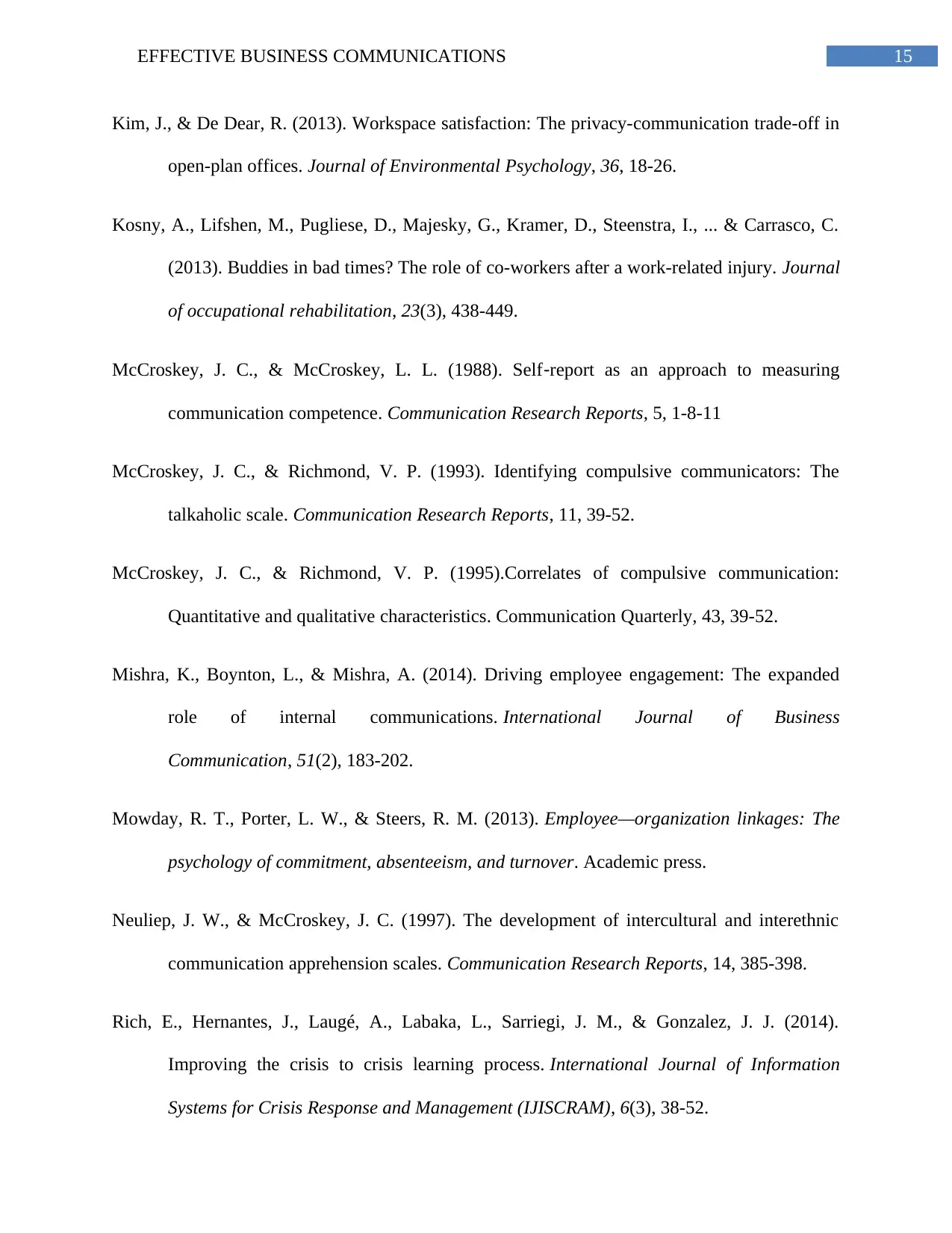
15EFFECTIVE BUSINESS COMMUNICATIONS
Kim, J., & De Dear, R. (2013). Workspace satisfaction: The privacy-communication trade-off in
open-plan offices. Journal of Environmental Psychology, 36, 18-26.
Kosny, A., Lifshen, M., Pugliese, D., Majesky, G., Kramer, D., Steenstra, I., ... & Carrasco, C.
(2013). Buddies in bad times? The role of co-workers after a work-related injury. Journal
of occupational rehabilitation, 23(3), 438-449.
McCroskey, J. C., & McCroskey, L. L. (1988). Self‐report as an approach to measuring
communication competence. Communication Research Reports, 5, 1-8-11
McCroskey, J. C., & Richmond, V. P. (1993). Identifying compulsive communicators: The
talkaholic scale. Communication Research Reports, 11, 39-52.
McCroskey, J. C., & Richmond, V. P. (1995).Correlates of compulsive communication:
Quantitative and qualitative characteristics. Communication Quarterly, 43, 39-52.
Mishra, K., Boynton, L., & Mishra, A. (2014). Driving employee engagement: The expanded
role of internal communications. International Journal of Business
Communication, 51(2), 183-202.
Mowday, R. T., Porter, L. W., & Steers, R. M. (2013). Employee—organization linkages: The
psychology of commitment, absenteeism, and turnover. Academic press.
Neuliep, J. W., & McCroskey, J. C. (1997). The development of intercultural and interethnic
communication apprehension scales. Communication Research Reports, 14, 385-398.
Rich, E., Hernantes, J., Laugé, A., Labaka, L., Sarriegi, J. M., & Gonzalez, J. J. (2014).
Improving the crisis to crisis learning process. International Journal of Information
Systems for Crisis Response and Management (IJISCRAM), 6(3), 38-52.
Kim, J., & De Dear, R. (2013). Workspace satisfaction: The privacy-communication trade-off in
open-plan offices. Journal of Environmental Psychology, 36, 18-26.
Kosny, A., Lifshen, M., Pugliese, D., Majesky, G., Kramer, D., Steenstra, I., ... & Carrasco, C.
(2013). Buddies in bad times? The role of co-workers after a work-related injury. Journal
of occupational rehabilitation, 23(3), 438-449.
McCroskey, J. C., & McCroskey, L. L. (1988). Self‐report as an approach to measuring
communication competence. Communication Research Reports, 5, 1-8-11
McCroskey, J. C., & Richmond, V. P. (1993). Identifying compulsive communicators: The
talkaholic scale. Communication Research Reports, 11, 39-52.
McCroskey, J. C., & Richmond, V. P. (1995).Correlates of compulsive communication:
Quantitative and qualitative characteristics. Communication Quarterly, 43, 39-52.
Mishra, K., Boynton, L., & Mishra, A. (2014). Driving employee engagement: The expanded
role of internal communications. International Journal of Business
Communication, 51(2), 183-202.
Mowday, R. T., Porter, L. W., & Steers, R. M. (2013). Employee—organization linkages: The
psychology of commitment, absenteeism, and turnover. Academic press.
Neuliep, J. W., & McCroskey, J. C. (1997). The development of intercultural and interethnic
communication apprehension scales. Communication Research Reports, 14, 385-398.
Rich, E., Hernantes, J., Laugé, A., Labaka, L., Sarriegi, J. M., & Gonzalez, J. J. (2014).
Improving the crisis to crisis learning process. International Journal of Information
Systems for Crisis Response and Management (IJISCRAM), 6(3), 38-52.
Secure Best Marks with AI Grader
Need help grading? Try our AI Grader for instant feedback on your assignments.
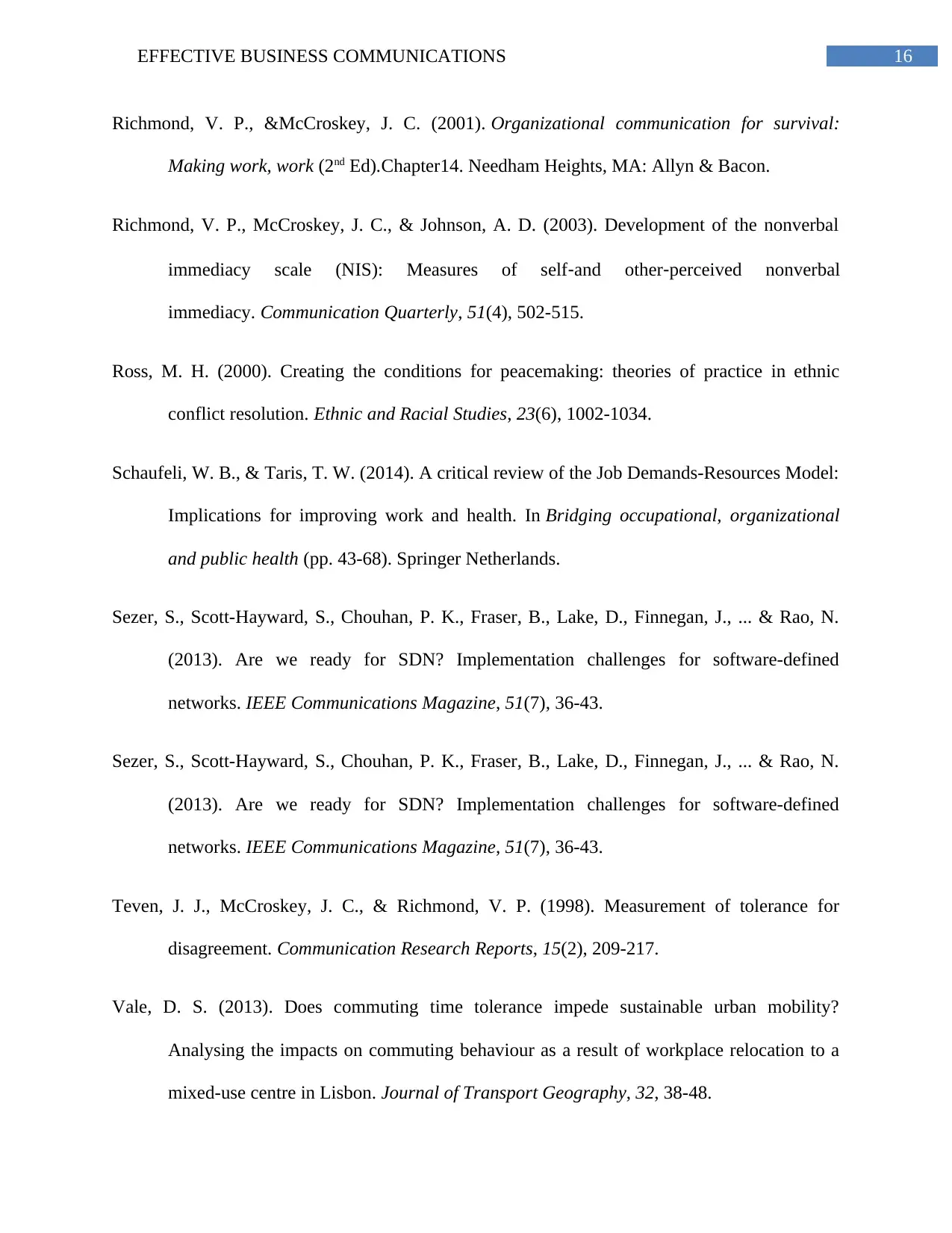
16EFFECTIVE BUSINESS COMMUNICATIONS
Richmond, V. P., &McCroskey, J. C. (2001). Organizational communication for survival:
Making work, work (2nd Ed).Chapter14. Needham Heights, MA: Allyn & Bacon.
Richmond, V. P., McCroskey, J. C., & Johnson, A. D. (2003). Development of the nonverbal
immediacy scale (NIS): Measures of self‐and other‐perceived nonverbal
immediacy. Communication Quarterly, 51(4), 502-515.
Ross, M. H. (2000). Creating the conditions for peacemaking: theories of practice in ethnic
conflict resolution. Ethnic and Racial Studies, 23(6), 1002-1034.
Schaufeli, W. B., & Taris, T. W. (2014). A critical review of the Job Demands-Resources Model:
Implications for improving work and health. In Bridging occupational, organizational
and public health (pp. 43-68). Springer Netherlands.
Sezer, S., Scott-Hayward, S., Chouhan, P. K., Fraser, B., Lake, D., Finnegan, J., ... & Rao, N.
(2013). Are we ready for SDN? Implementation challenges for software-defined
networks. IEEE Communications Magazine, 51(7), 36-43.
Sezer, S., Scott-Hayward, S., Chouhan, P. K., Fraser, B., Lake, D., Finnegan, J., ... & Rao, N.
(2013). Are we ready for SDN? Implementation challenges for software-defined
networks. IEEE Communications Magazine, 51(7), 36-43.
Teven, J. J., McCroskey, J. C., & Richmond, V. P. (1998). Measurement of tolerance for
disagreement. Communication Research Reports, 15(2), 209-217.
Vale, D. S. (2013). Does commuting time tolerance impede sustainable urban mobility?
Analysing the impacts on commuting behaviour as a result of workplace relocation to a
mixed-use centre in Lisbon. Journal of Transport Geography, 32, 38-48.
Richmond, V. P., &McCroskey, J. C. (2001). Organizational communication for survival:
Making work, work (2nd Ed).Chapter14. Needham Heights, MA: Allyn & Bacon.
Richmond, V. P., McCroskey, J. C., & Johnson, A. D. (2003). Development of the nonverbal
immediacy scale (NIS): Measures of self‐and other‐perceived nonverbal
immediacy. Communication Quarterly, 51(4), 502-515.
Ross, M. H. (2000). Creating the conditions for peacemaking: theories of practice in ethnic
conflict resolution. Ethnic and Racial Studies, 23(6), 1002-1034.
Schaufeli, W. B., & Taris, T. W. (2014). A critical review of the Job Demands-Resources Model:
Implications for improving work and health. In Bridging occupational, organizational
and public health (pp. 43-68). Springer Netherlands.
Sezer, S., Scott-Hayward, S., Chouhan, P. K., Fraser, B., Lake, D., Finnegan, J., ... & Rao, N.
(2013). Are we ready for SDN? Implementation challenges for software-defined
networks. IEEE Communications Magazine, 51(7), 36-43.
Sezer, S., Scott-Hayward, S., Chouhan, P. K., Fraser, B., Lake, D., Finnegan, J., ... & Rao, N.
(2013). Are we ready for SDN? Implementation challenges for software-defined
networks. IEEE Communications Magazine, 51(7), 36-43.
Teven, J. J., McCroskey, J. C., & Richmond, V. P. (1998). Measurement of tolerance for
disagreement. Communication Research Reports, 15(2), 209-217.
Vale, D. S. (2013). Does commuting time tolerance impede sustainable urban mobility?
Analysing the impacts on commuting behaviour as a result of workplace relocation to a
mixed-use centre in Lisbon. Journal of Transport Geography, 32, 38-48.
1 out of 17
Related Documents
Your All-in-One AI-Powered Toolkit for Academic Success.
+13062052269
info@desklib.com
Available 24*7 on WhatsApp / Email
![[object Object]](/_next/static/media/star-bottom.7253800d.svg)
Unlock your academic potential
© 2024 | Zucol Services PVT LTD | All rights reserved.

